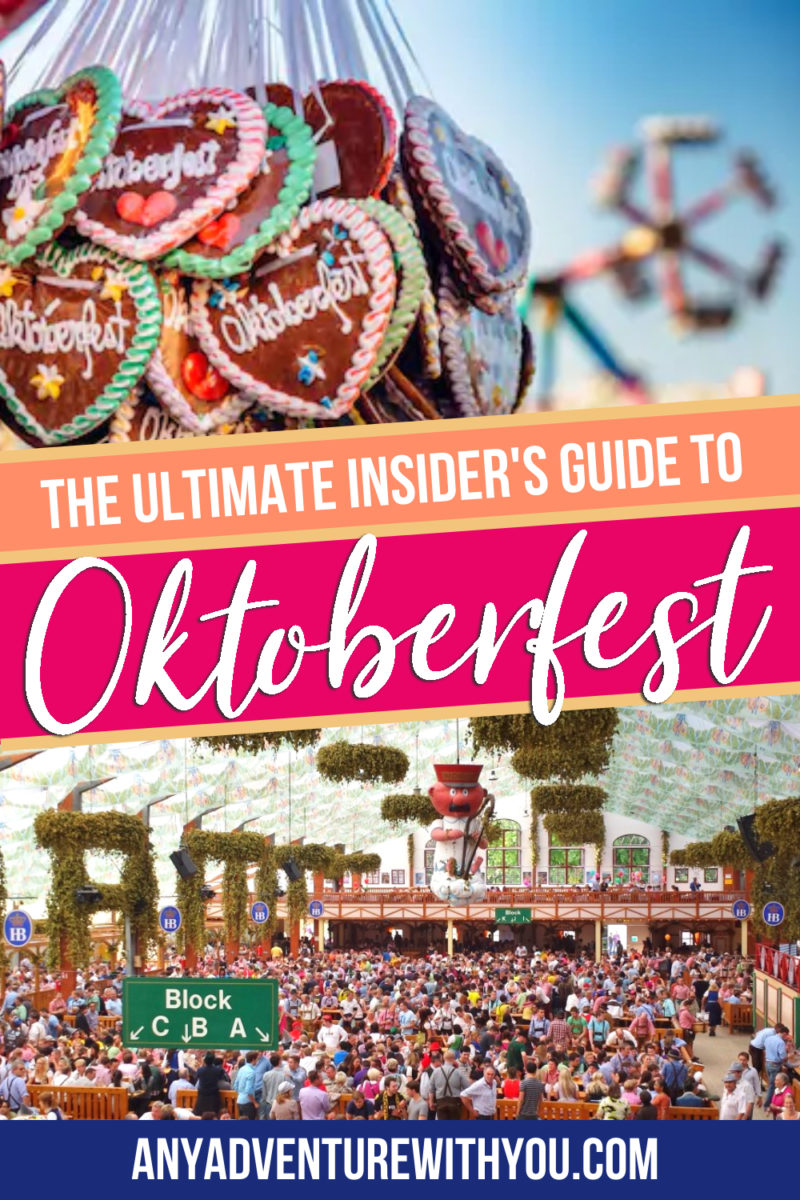
The first time we were at Oktoberfest, I remember sitting in the Hofbrau tent and looking around. Here I was, sitting in a dirndl, drinking a German beer out of a stein, listening to music and munching on a pretzel. I looked around and thought, “This is some of the most fun I have ever had!” And we had so much fun that we came back again right away the next year 😀 And we found that our time at the fest left us with so much knowledge, we had to capture it all in an Oktoberfest guide.
Having been to Oktoberfest twice now and having spent more than a week at the Fest itself, I have learned a lot about the Weisn. Like, do you know the best way to get a seat at a table itself? What foods should you eat? What should you wear? I took all of this knowledge and put it in this post here. It might be a little long, but I think it’s worth it – because there is no better experience than Oktoberfest. Are you headed to Oktoberfest or thinking about going? This Oktoberfest guide will not only tell you but also explain everything that you need to know about the fest! Let’s get started.
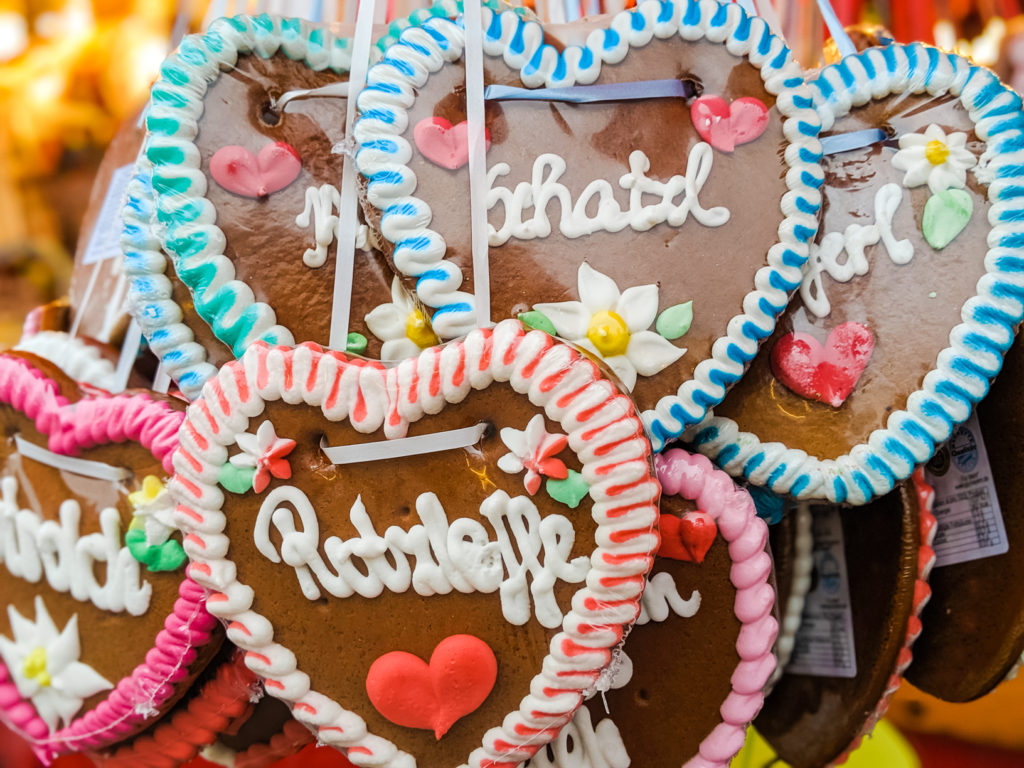
What This Post Covers:
Oktoberfest Guide: When and Where
Oktoberfest is a German tradition that began in 1810, in celebration of the wedding of Prince Ludwig and Princess Theresa. The celebration has occurred every year since, starting in the middle of September and going until the first Sunday in October. This means that the length of the festival can vary from 16 to 18 days, depending on the calendar year. It’s one of the biggest tourist attractions in Germany, drawing 7 million people on average to the festival grounds.
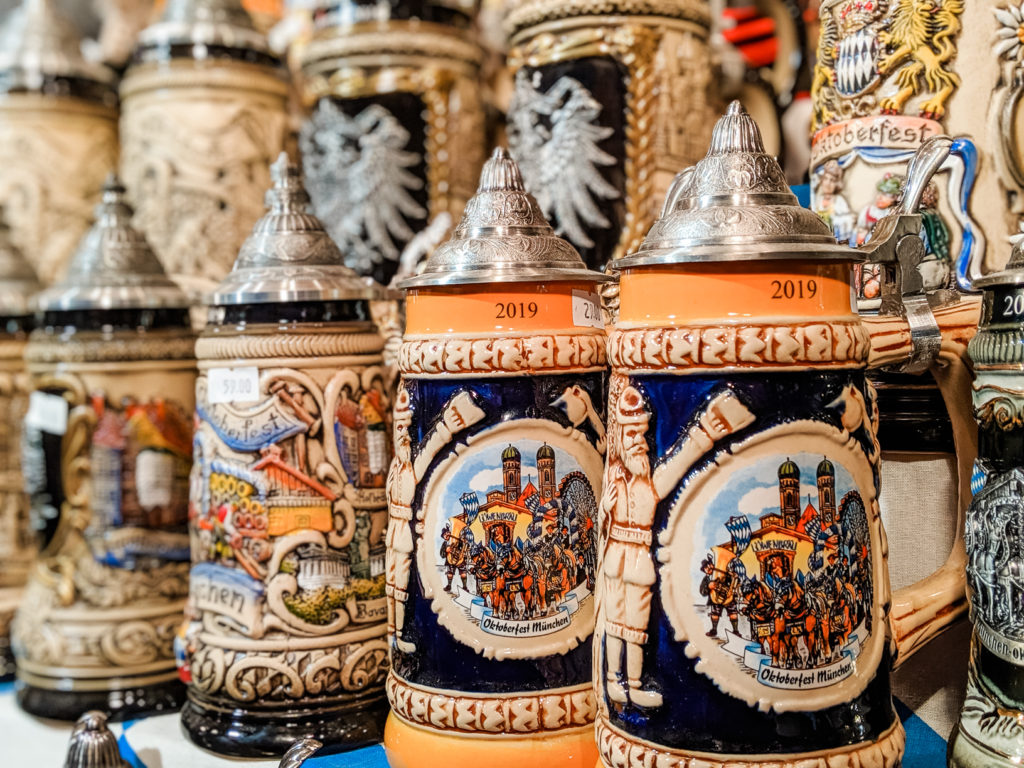
Oktoberfest 2020 Dates & Hours
Oktoberfest 2020 happens from Saturday, Sept. 19 until Sunday, Oct 4. The festival opens on the third Saturday of September, with the Munich mayor tapping a keg at exactly noon and declaring, “O’zapft is!” (“It’s tapped!”) and then the festival is officially opened until the first Sunday in October.
Opening Day: 9:30 a.m. (tents), 12:00 p.m. (festival) – 11:30 p.m.
Weekdays: 10:00 a.m. – 10:30 p.m.
Weekends: 9:00 a.m. – 10:30 p.m.
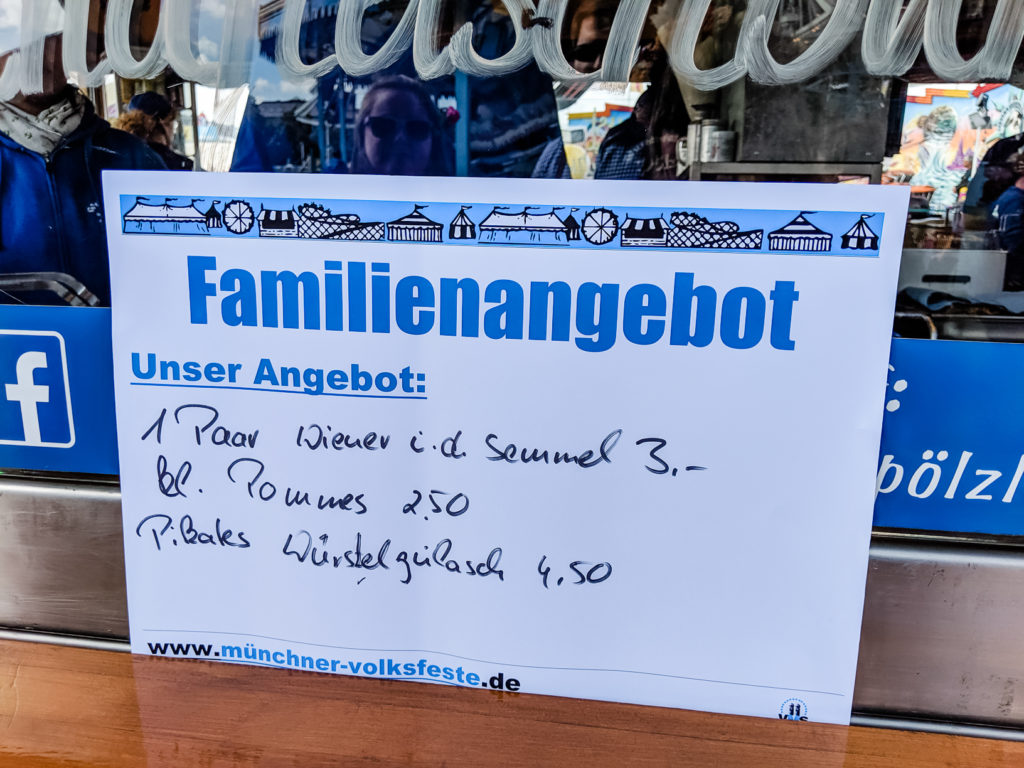
Other Oktoberfest Hours
- Late Night Tents – There are two late-night small tents that are open from 11:30 a.m. and close at 12:30 a.m. The tents include Käfer-Weisn-Schänke and the wine tent Kuffler’s Weinzelt.
- The Fair – The stalls at Oktoberfest are generally open around 9 or 10 a.m. and close at either 11:00 p.m. or midnight, depending on what day of the week it is. Hours are usually posted on the ticket booths or outside of each tent, so make sure to check before you enter a tent if you want to ride an attraction or grab late-night food.
- Small Tents – The small tents, like the cafes, snack or coffee tents, are open at the same time as the large tents and close at 11 p.m.
- Family Day – On both Tuesdays of the festival, the rides and many of the stalls will have “family day.” This will mean there are discounted food and rides all throughout the festival, and they last until 7 p.m. each Tuesday. You can recognize which stands are participating by looking for the blue “family day” signs that are placed near the ticket booths or on the food menus.
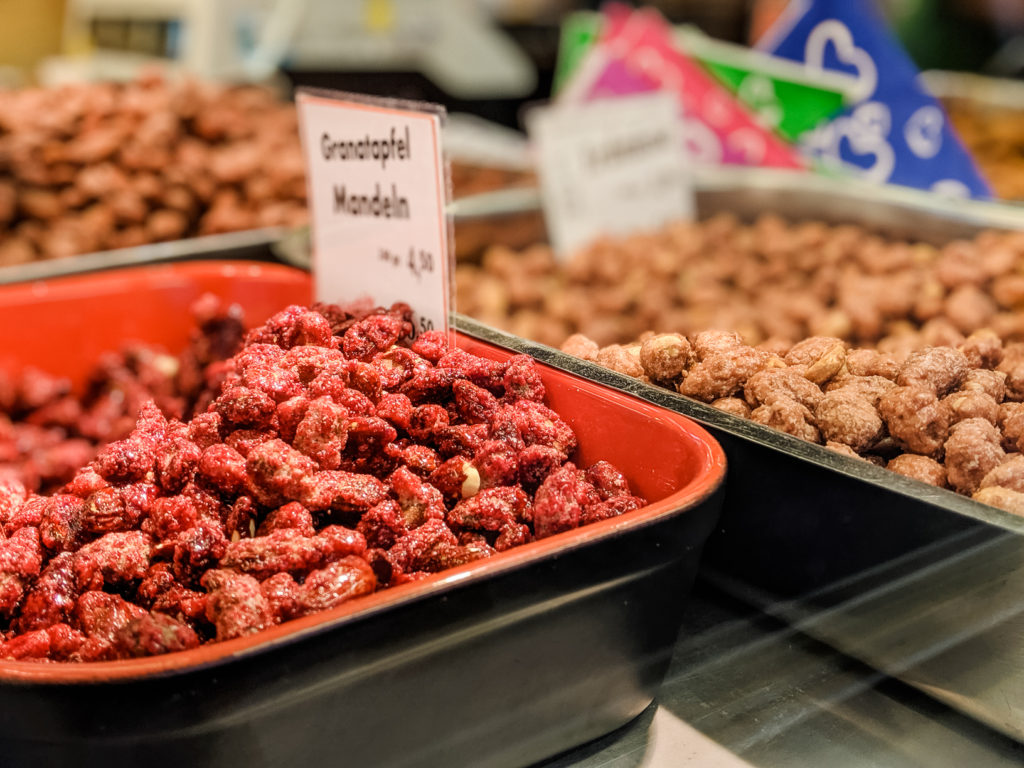
Oktoberfest Guide to Budgeting
Oktoberfest is not the cheapest vacation. Between flights, hotels and buying many liters of beer, costs will add up. Many vendors within the city also typically increase prices during the fest, as they know it attracts many tourists, which makes finding reliable but cheap accommodations hard to find. Therefore, don’t expect this to be the budget vacation of your dreams.
Here’s an Oktoberfest guide to estimate how much you will probably spend at:
- Flights: at least $1,000/person
- Hotel: at least $300/night
- Daily
expenses:
- €12 euro per liter of beer
- €5 euro per liter of water
- €10-25 euro per meal
- €5 euro per pretzel or snack
- Additional
expenses: (prices will vary)
- Any rides or games you want to play at the fest
- Souvenirs or other take-home items
- Trachten (if you choose to purchase it)
Between beer, food, and games, we probably spend around an average of $150-$200 a day for two people at Oktoberfest.
The best way to save money? Book early. The earlier you can grab reservations, for both flights and hotels, the less of a chance that they have been price-gouged for the fest.
You must have cash when attending the festival. All tents only accept exact cash for beer and food, and most stalls and rides prefer cash as well. There are ATMs on-site that charge an exorbitant fee, so make sure to bring more cash with you every day than you think you will need. You can keep the cash safe by putting some in your wallet, and some else in a sock, bra, etc.
PRO TIP: I always keep a €20 note and my hotel key tucked away somewhere on my person when attending, so if something happens, I can get home without a problem, especially if I have had a few drinks.
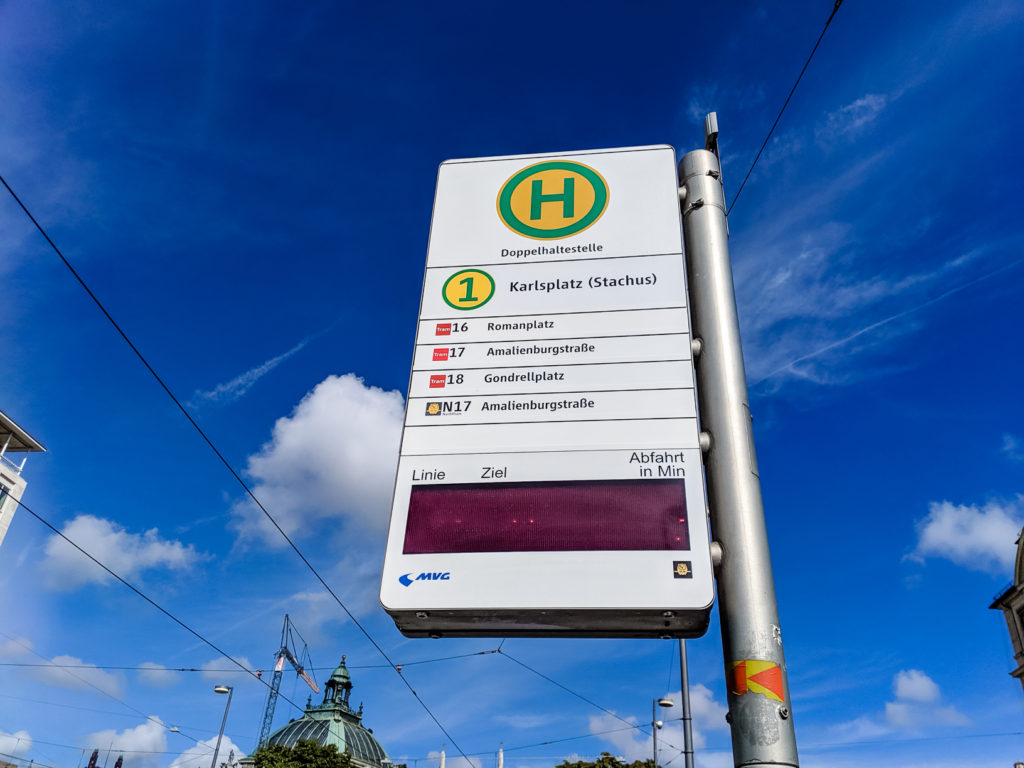
Oktoberfest Guide – How to Travel to & Where to Stay
Traveling to Munich is the easy part – finding a place to stay that is within your budget and close to the Weisn is the hard part. That’s why there is one thing that I recommend as part of this Oktoberfest guide is: book early.
Book both your flights and your hotel as early in the year as possible. The best time of year to book is about 6-8 months before the fest, so it’s advisable to start looking and book both between January and March. If your airline or preferred hotel can book earlier, do so. The prices will only go up every month that it gets closer to September.
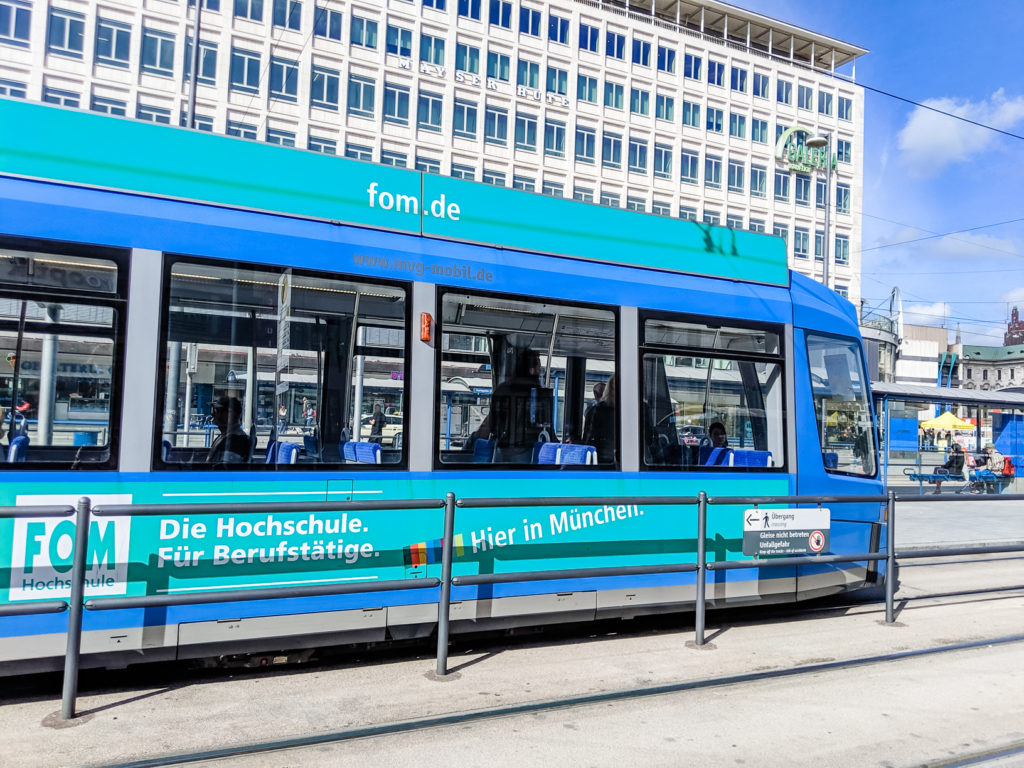
Getting to Munich
The nearest major airport to Oktoberfest is Munich Airport (MUC). Most major airlines fly in and out of here, and the airport is extremely nice with plenty of stores in both the departing and arriving terminals. However, a word of caution: we purchased water in the MUC airport so we could start hydrating before heading to Oktoberfest later that day. It ended up costing us almost €30 for three bottles – make sure to purchase anything you need once you exit the airport or before you leave for Munich.
The airport itself is about 30-45 minutes outside of Munich itself, depending on which train you take and where you are going. To get there, you will have to take the S-Bahn from the station outside of the airport. Before you exit the airport itself, there are a few S-Bahn ticket stations. Buy your tickets here as there are typically short lines and you can take your time purchasing your tickets.
When you land in Munich, customs is typically very fast. From there, you can head down, purchase your ticket near the exit of the airport. Then, head outside of the airport, cross through the shopping center and take the escalator down to get to the S-Bahn station that will take you into town. Usually, the S7/S8 train will get you to where you need to be, but make sure to look up which train in which direction you will need to take to get to your hotel before you arrive in Munich – the train stations are almost completely in German. The station is also very small, and the trains come in and out very fast, so it’s better to be sure about which train you are taking rather than panicking and taking the wrong train.
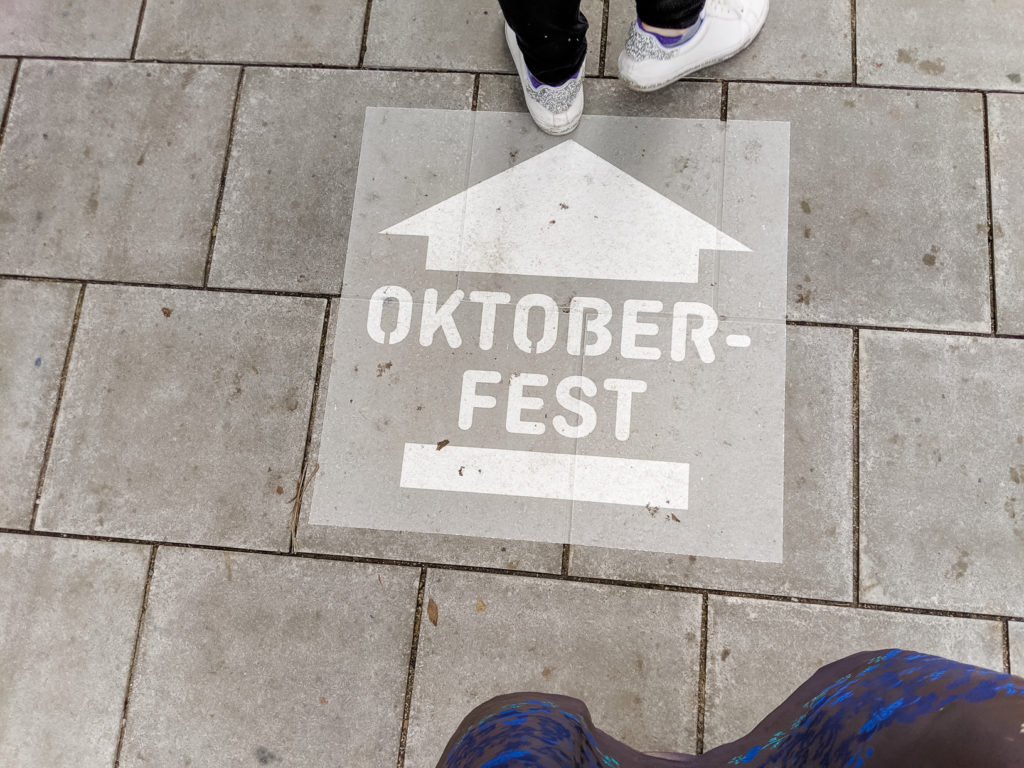
Getting Around Munich
Munich is a very pedestrian-friendly city with plenty of public transportation options. There is an underground subway system, an overground tram system, as well as a bus line that goes around the city. Many of these options will stop right outside of Oktoberfest.
Munich Public Transportation Options
- Underground (U-Bahn/S-Bahn) – The S-Bahn is the underground train that goes to areas surrounding Munich. The U-Bahn goes within the city. Unless you are staying far from the Fest, you will most likely only utilize these systems when you are going to/from the airport.
- Strassenbahn – The Strassenbahn is the above-ground tram. This is our main form of transportation once we are in the city and can get you to a wide variety of places within the city. A tram ride from the city center to the fest is only about ten minutes.
- Bus – There is a bus system that goes around We found the tram to be quicker, but the bus is a great way to get to further areas of the city without having to switch between different trains.
- Pricing – Munich has a pricing system for public transportation that includes different zones. Unless you are staying outside of the city, and with the exception of going to and from the airport, you will most likely be traveling in Zone 1. A single-way ticket will cost €2.60/person with a day-long ticket costing around €7-€8. One day-long ticket can be used on all three systems (the Underground, the Strassenbahn and the bus).
Other Transportation Options
- Uber – Uber is an option in Munich but can be very expensive. If you’re not staying far from festival grounds, you are better off utilizing a taxi or public transportation.
- Taxi – Plenty of taxis can be found throughout the city, and many will wait outside of Oktoberfest to drive patrons’ homes. These can be expensive but are a good way to get home, especially after a few beers.
- Other options – One of the things we loved doing when leaving Oktoberfest was hiring a pedicab. It cost about €20 for a ride from the fest to our hotel, but it was a fun option that was essentially door-to-door.
When we were in Munich, we used Google Maps to help us know when and which train to take. The nice part about having this was it let you know exactly how long until your train/bus was there, which train to get on (left or right), and how many stops to take. This was helpful as there wasn’t much English on the public transportation options, so we knew we were going to the right place and not getting lost.
PRO TIP: Munich uses an honor system on most public transportation. This means that while you don’t have to scan your ticket to get on, especially on the tramway, there is a fine of at least $75 and maybe even jail time if you are caught without a ticket in hand. And they do check – we have seen multiple fare officers on the trains, especially around Oktoberfest. With ticket prices being extremely cheap, it’s better to be safe than sorry and purchase an all-day ticket before heading to the fest or anywhere else in the city.
Visit the official Oktoberfest website to see the specific public transportation stops that you will need to get off to visit the fest.
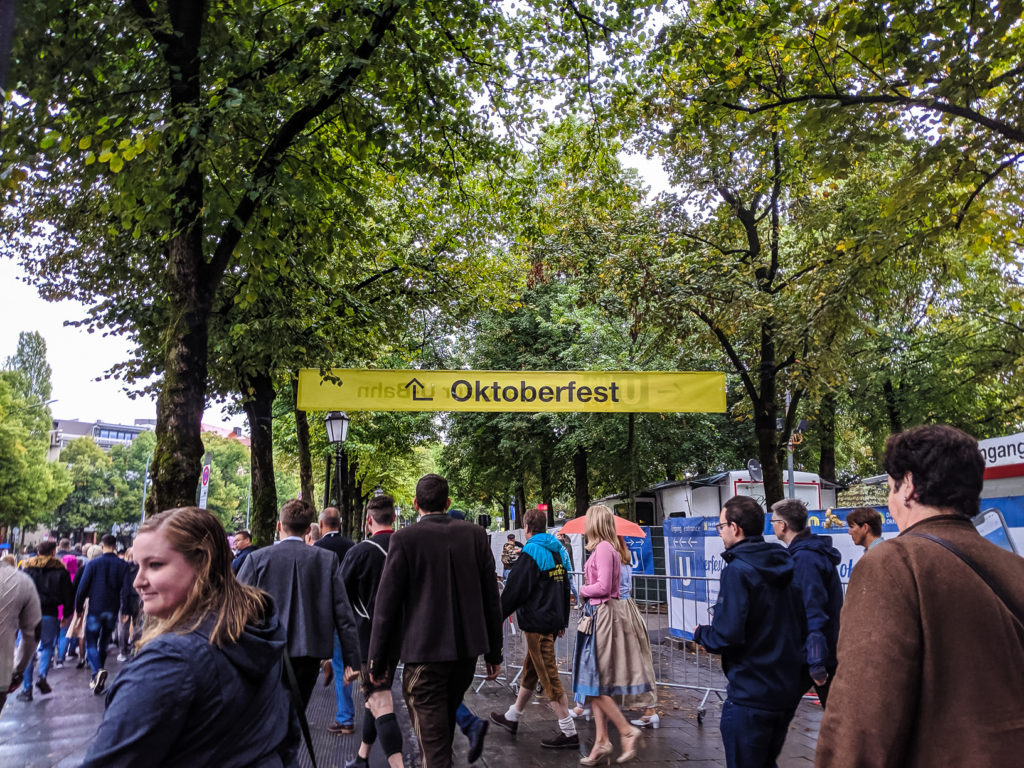
Where to Stay
One of the big tips of my Oktoberfest guide is when trying to figure out where to stay, do a lot of hotel research. Especially around Oktoberfest, hotel prices will rise quickly. Therefore, I highly recommend that you do a lot of research as to what part of the city you want to stay in. Personally, I recommend staying in the center of the city. If you book early enough, you’ll find that it won’t be hard to find a hotel there.
The center of town is a neighborhood called “Marienplatz” which is also where most of the city’s shopping and tourist area. It’s a great part of town to stay in, as there are plenty of other activities and restaurants around here outside of Oktoberfest. If you want to get particularly close to the festival, you can also stay in the “Karlsplatz” neighborhood.
Even if you don’t want to stay in these neighborhoods, your goal is to be no further than a 20-25-minute walk or train ride from the Oktoberfest festival grounds, called the Theresienwiese. Any further, and you risk having trouble getting home after a long day of drinking. The best
For example, we had friends who booked an Airbnb outside of the city and saved an incredible amount of money over us. However, when they left Oktoberfest drunk, they found that they still had to take a half an hour bus ride out of the city before walking another 15 minutes. They all admitted the trip itself was already a splurge, and they would have rather just spent the extra money and stayed closer.
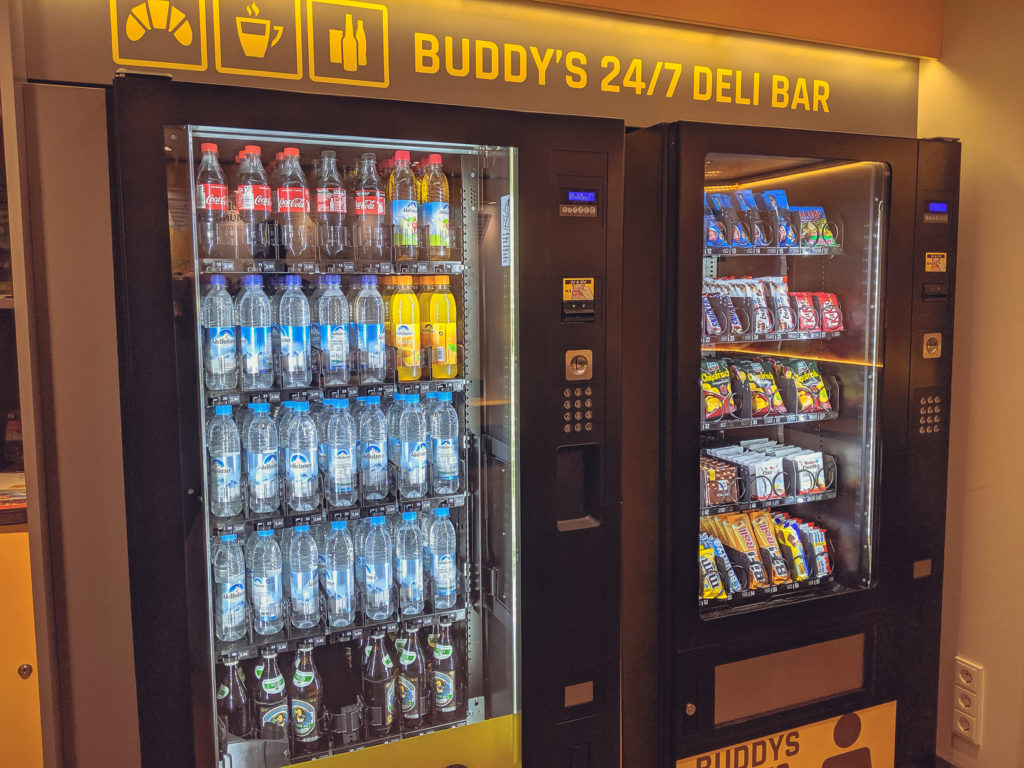
Our Hotel Recommendation
Personally, our favorite hotel is Buddy Hotel. I recommend it in this Oktoberfest guide, as we feel it is the perfect hotel for a variety of reasons:
- Its location is right next to the Karlsplatz train station (like literally – you come up the escalators and turn to the left and it’s right there).
- From the hotel, it’s a 20-minute walk to Oktoberfest. You can also take the tram that stops right in front of the hotel to the festival grounds.
- It’s also close enough to the fest, that when we came up from the underground during our second trip to Oktoberfest, we were standing next to the costume parade route!
- It’s a 10-minute walk to Marienplatz, so it is easy to walk over there and take in some of the famous restaurants located in this part of town.
- Next to the hotel is an underground U-Bahn station that has dozens of shops, including many restaurants, a grocery store, a pharmacy, and a few clothing stores. Everything you need is down here, which makes it easy to grab a bite to eat or some Gatorade for your hangover before heading right back to the fest!
- It’s cheaper than most hotels in the area. The hotel is modeled after a European model, meaning that some of the frills are gone in return for a cheaper stay.
- This means you won’t have room service, and there is only one person working at the front desk, but in return, you get a much cheaper rate.
- The rate does include housekeeping and the best part? There’s a vending machine in the lobby that serves ice-cold beers for cheap!
Even if you don’t choose to stay here, it’s a good barometer for the area of town that you should be looking to stay in.
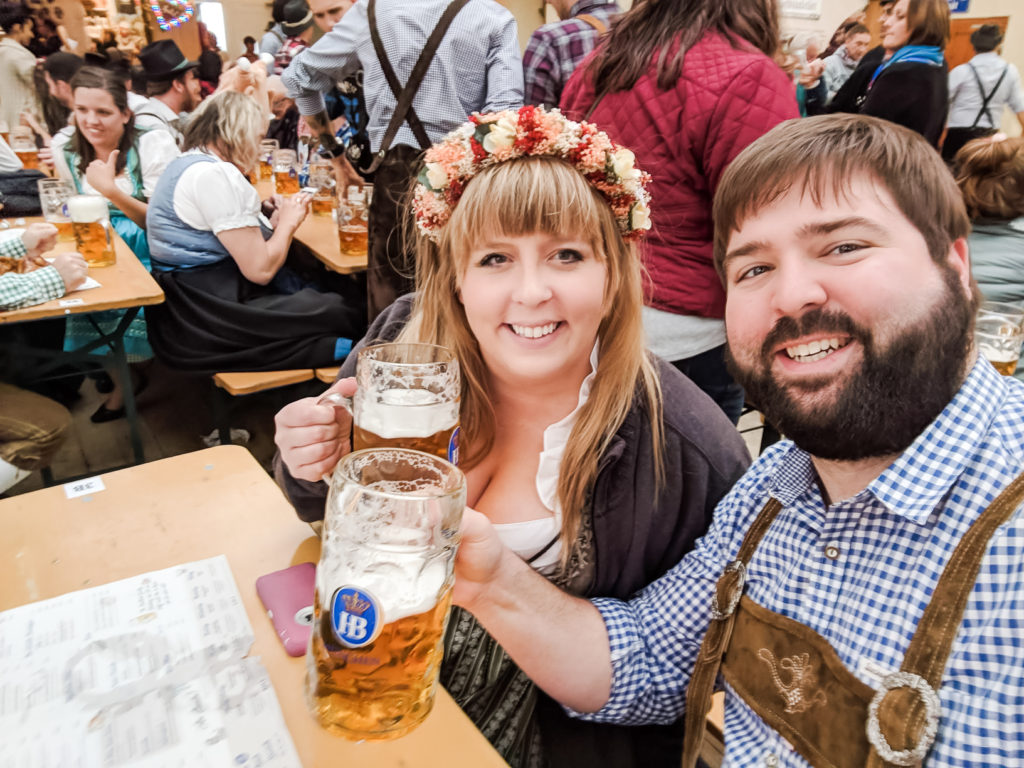
Oktoberfest Guide – What to Wear
The long and the short of it is wear whatever you want. No one is going to scoff or blink an eye if you show up in jeans a T-shirt. Plenty of people do it, and you won’t stand out a bit.
BUT, and this is a big but, I personally highly recommend that you wear traditional German outfits, also known as “trachten.” Women wear long dresses with a blouse and apron which are called “dirndls” and men wear leather overall pants with tall socks called “lederhosen.”
We highly recommend wearing trachten because almost everyone else at Oktoberfest will be! Again, you won’t be the odd man out if you don’t, but in my opinion, it’s fun to dress the part. And when else are you going to get to dress up in traditional clothing to go drinking?
PRO TIP: No matter what you wear to Oktoberfest, make sure to wear comfortable shoes. We opt for supportive running/walking shoes, even in our trachten. You will walk and be on your feet a LOT at the fest, and you don’t want to slip when walking through sticky beer covered floors.
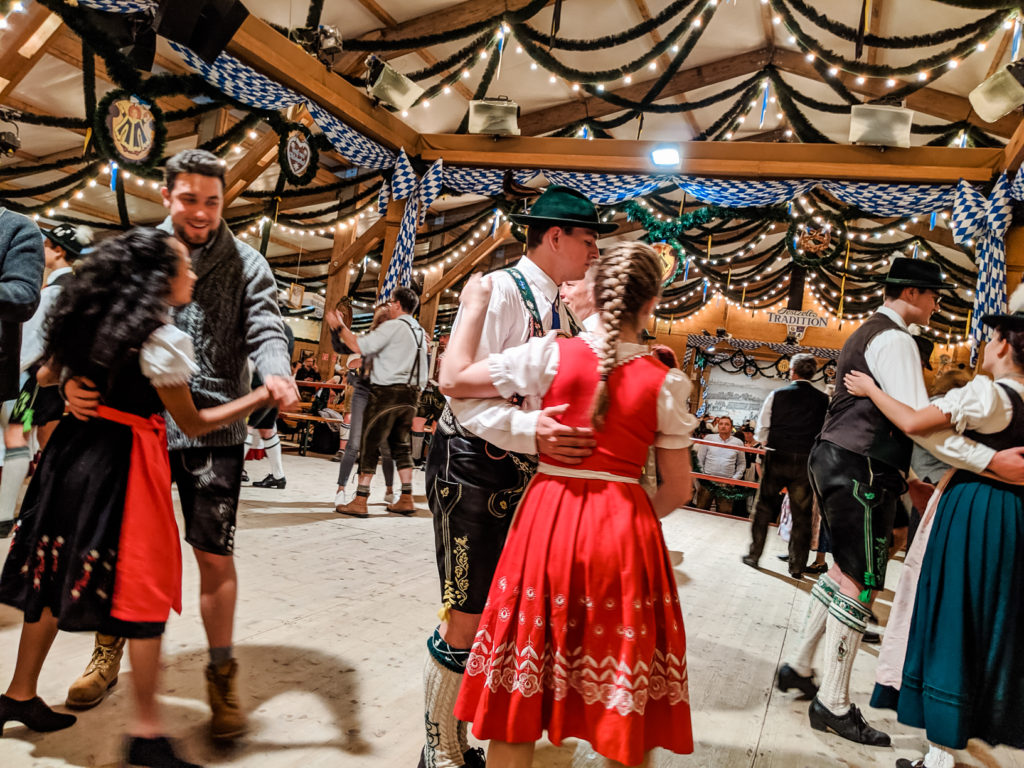
Where to Buy Trachten
A big tip of this Oktoberfest guide: If you do decide you want to buy trachten, make sure to buy it before you head the fest. This is because you won’t be able to buy it at the fest itself. You can find some on Amazon, but I don’t recommend them. Why? Mainly because you will be spending a similar amount of money. If you’re doing that, why not buy the real stuff in town? You don’t have to spend a fortune to get authentic trachten.
There are dozens of trachten stores that pop-up around Munich during Oktoberfest. We found some of the biggest areas with trachten to be on Marienplatz, along the route from Karlsplatz to the fest, and then around the entrance to the fest itself. You can walk in any of these and purchase trachten. If you want more “authentic” trachten, then it may be worth it to find a store that sells it year-round. Note: Most stores sell plus size and small size trachten, so no matter what size you are, you will be able to find a beautiful outfit!
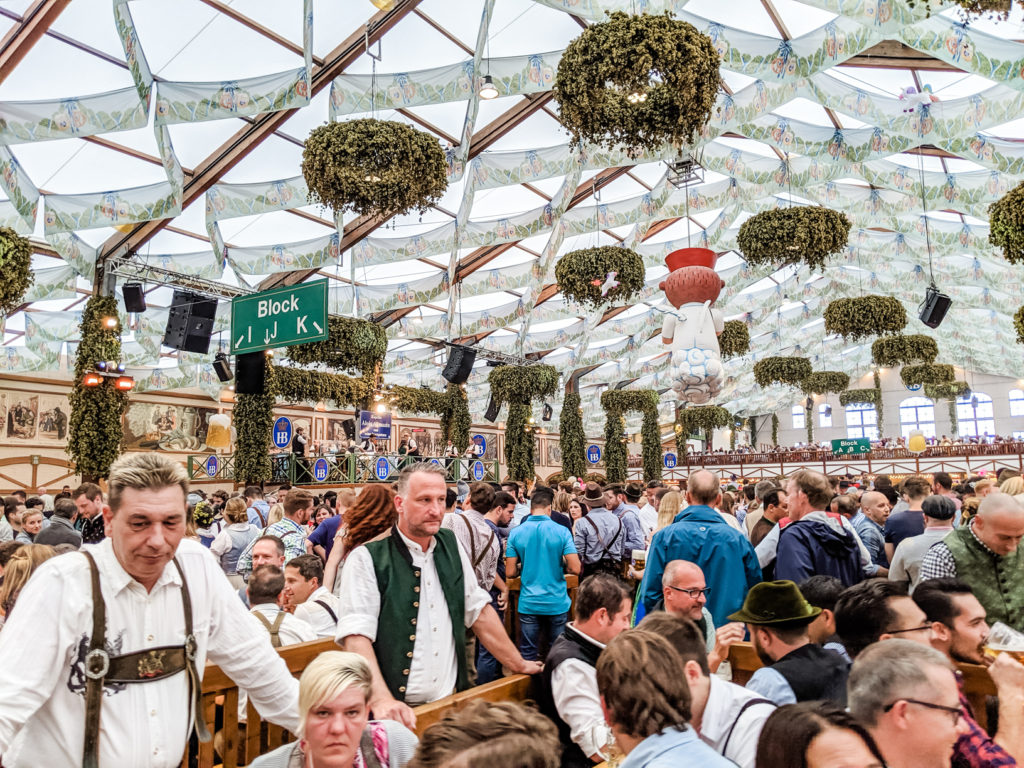
How to Purchase & Wear Trachten
Once you’ve found where you want to purchase trachten, here are the basics of what you need to buy:
- Dirndls:
- Dress
- Apron
- Blouse
- Lederhosen:
- Overalls
- Checkered shirt
- Tall socks
You can buy some additional items to wear with your trachten, such as hats, jackets, and shoes, but trachten is not cheap, which is why I didn’t recommend it. You can expect to spend around $120-$150 for women, around $75 for men.
If you want something authentic, look for these few things. Otherwise, you aren’t really getting “authentic” trachten, and you would have been better off purchasing on Amazon beforehand and saving the difference. For dirndls, make sure what you buy is cloth, not polyester. For lederhosen, try to find one that is leather rather than plastic.
When finding trachten that fits, make sure that you are looking for a few things. For women, find a dirndl that comes past your knees. Shorter dirndls are more modern and are not looked upon as kindly by the locals. Additionally, the way you tie the ribbon on your apron indicates your relationship status: right is for taken/married, left is single, the center is if you’re a virgin and tying it in the back indicates that you are a widow. For men, make sure to sit in your lederhosen before purchasing, as it can ride up once you sit down. Look for a pair of lederhosen that has pockets and a flap in the front. Also, make sure that you find a pair of socks that come up your legs – you’ll be cold in the German weather, so taller socks will keep you warm.
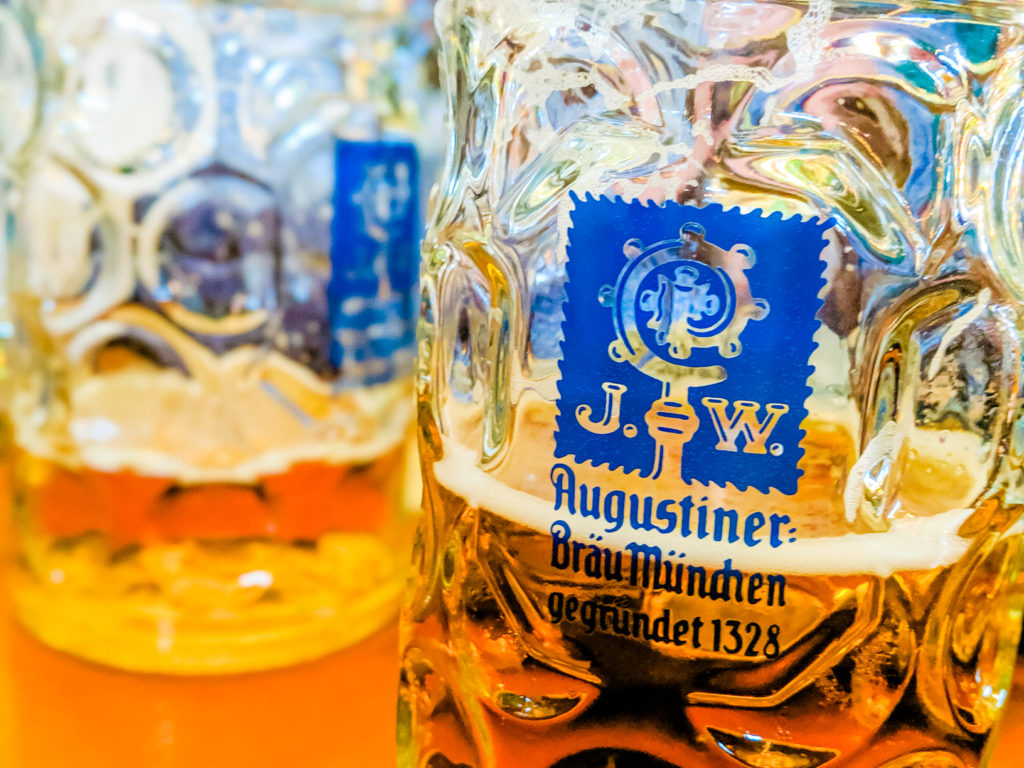
Oktoberfest Guide – What to Know Before you Go
While it may feel like you’re attending any old beer festival, Oktoberfest is much more than that. In order to have a good experience, this Oktoberfest guide will tell what you need to know before you go.
What to Bring
Unlike other fairs or festivals, you can’t bring much into Oktoberfest. Security is tight at the entrances, so make sure to follow the guidelines before you head in.
- Don’t bring a backpack – Before you enter, there will be security with bag check who will look through anything you will be bringing into the festival. They will stop you if you have any large bags.
- If you do need to bring a large item to Oktoberfest, like luggage, there is a bag check at each entrance. It costs
- Bring a small purse – DO bring a small purse. The largest purse you can bring in can be no bigger than three liters. You can purchase one inside Oktoberfest as a souvenir, and they hold a surprising amount of stuff!
- Carry cash – Cash is the only thing accepted in the tents, so carry cash and carry enough of it to cover your food and drinks for the whole day!
- Anything you might need during the day – Such as a phone charger/external battery, any medicines you might need during drinking like tums, Chapstick, tissues, etc. There aren’t any convenience store-type stands at the fest, so bring anything you might need during the day – otherwise, you might find you have to leave the fest.
- Download the app on your phone – The app is a great way to get around the festival, know what is happening that day and choose which tent to sit in. There is an interactive map on the app which tells you how close to capacity each tent is, which can help you pick which tent to head to!
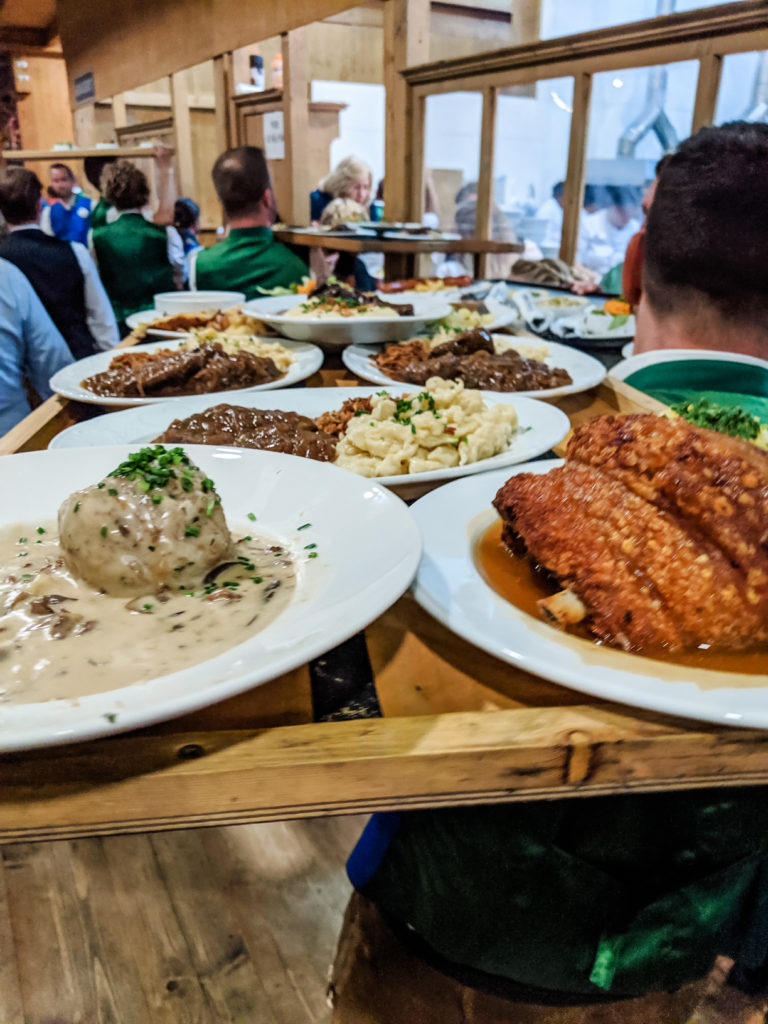
What to eat
In the tents – Every tent will have food menus that are typically in German. If you want to eat while sitting at your table, you can ask your server for an English version. Food served in the tents is very traditionally German, so you will find that the menu consists of halves of chicken, dumplings and pork knuckles. The food is very classical and not very greasy, so it may not taste particularly good after drinking, but will be good to fill up on before you have too much. I recommend getting the kaesespaetzle (German mac and cheese) or the pork knuckle (fried pork hock!)
There will also be “bread ladies” that go around the tents with baskets of different kinds of bread, including pretzels. Even if you don’t eat a full meal in the tents, I highly recommend you grab a pretzel to help soak up some of the beer!
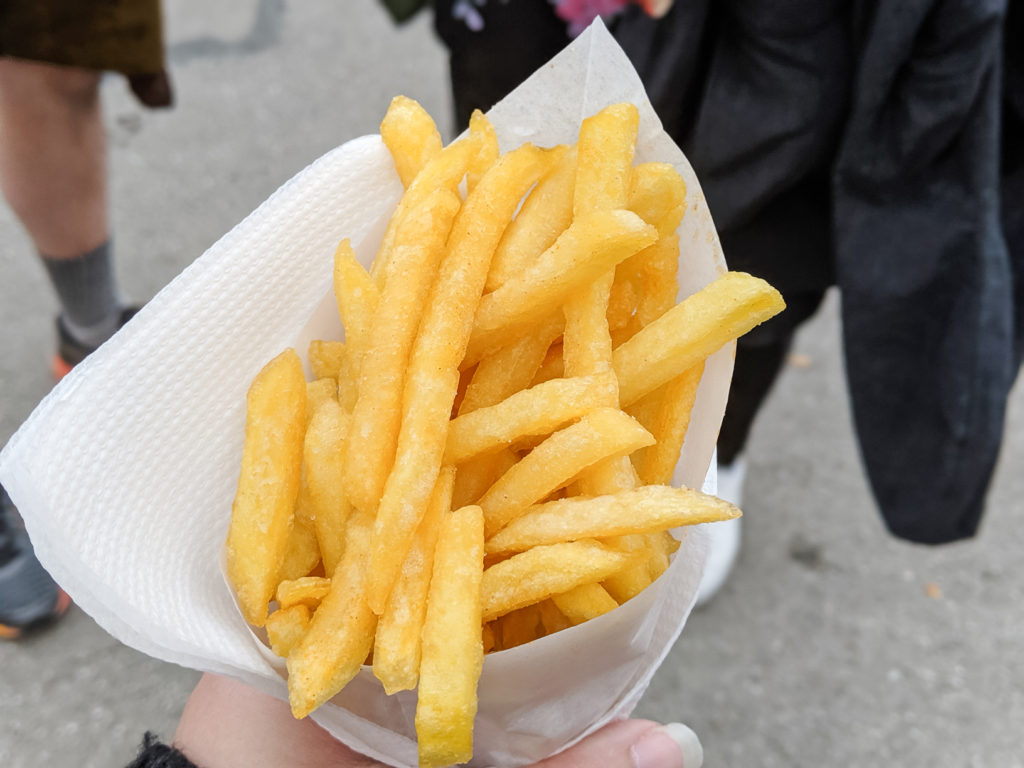
At the festival – Food at the festival is very much a mix of fair food and traditional German food. You can find some fried foods alongside traditional German sausages and sauerkraut. The festival food stands stay open after the tents close, so this is a great place to grab some food after a long day of drinking.
I highly recommend that you eat some French fries. Seriously, if you don’t eat anything else (which you should, because it’s a lot of drinking), eat these. They are the best things at the festival! I don’t know why they are so different from American fries, but they are some of the best fries you will eat. Germans dip their French fries in mayonnaise, so make sure to do as the locals do and get a good dab of mayo with them. I also highly recommend the steak sandwich – they are extremely filling and are great after a day of drinking.
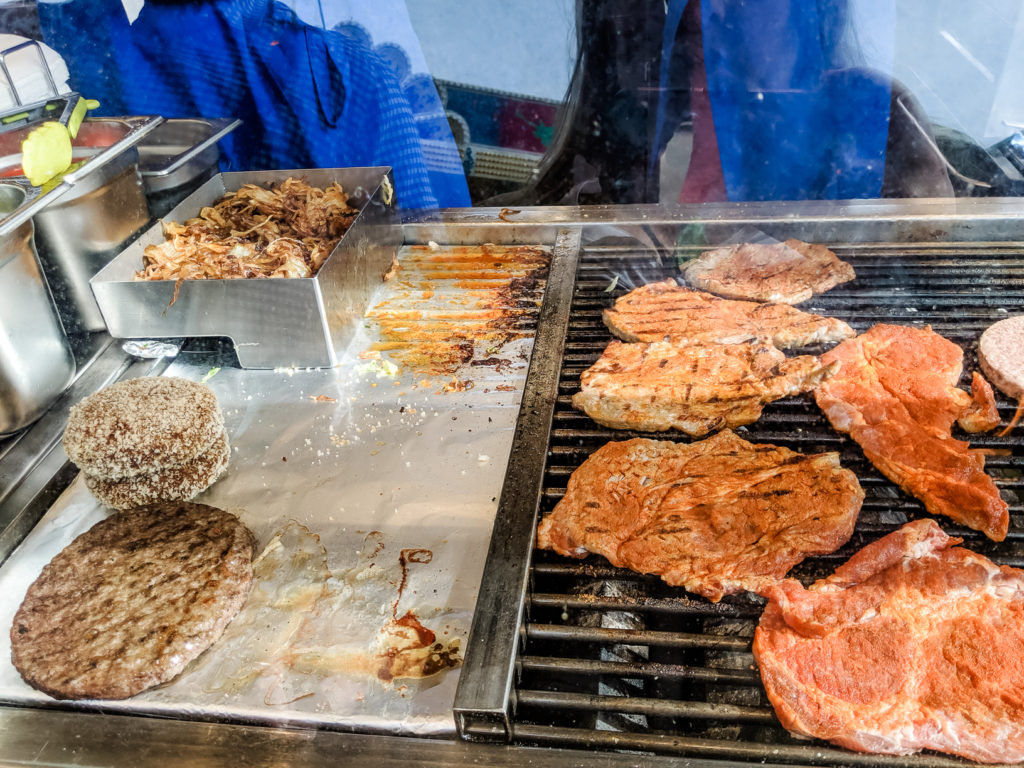
Additional Oktoberfest Guide Tips
Weather at Oktoberfest
Germany is close to the alps, and because of that, the weather tends to be much cooler there than most of the United States. Typical weather for Oktoberfest is usually around 50-60° during the day and can get down to 30-40° at night. Make sure to bring a jacket, especially if you end up sitting outside at a beer garden. And you can also zip anything in a jacket that you would have otherwise brought in your purse.
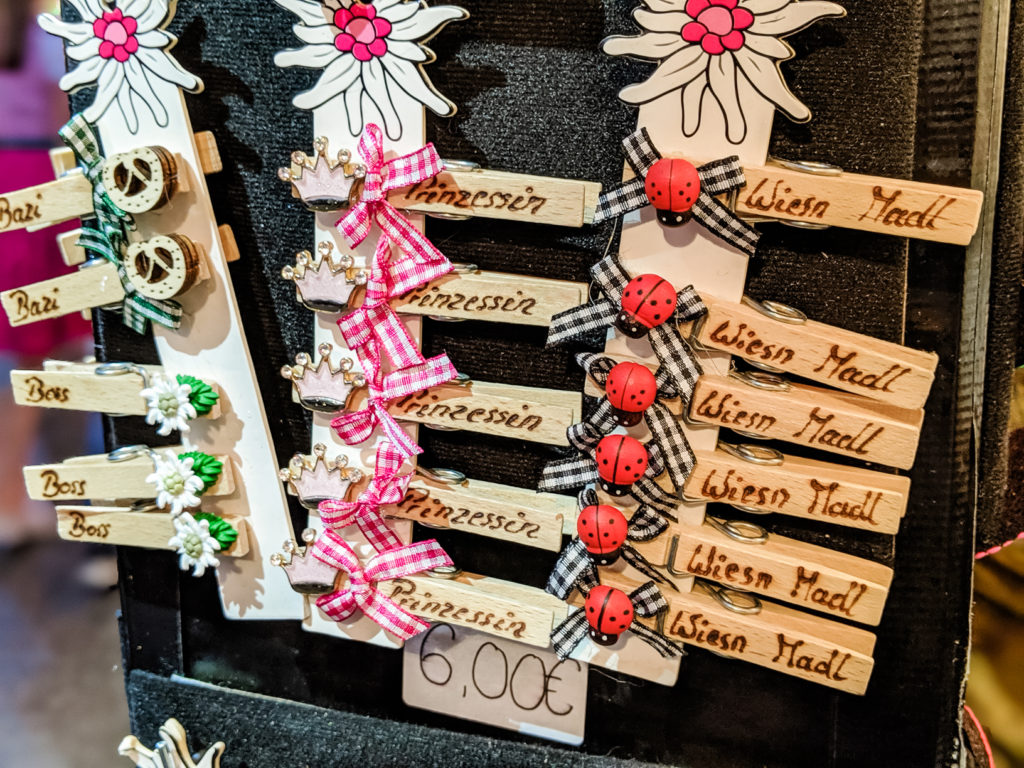
Souvenirs to Purchase at Oktoberfest
There are a wide variety of souvenirs to purchase throughout Oktoberfest. Some tents have souvenir stands, others have waitresses walking around with souvenirs (as well as taking commemorative polaroid photos, and waitresses selling tchotchkes like hats and balloons) and there are also plenty of stands selling souvenirs throughout the fest. Make sure to purchase souvenirs at the end of the day so you’re not carrying them around while you’re drinking.
- Heart-shaped gingerbread – Lebkuchenherz (German for “gingerbread heart”) are sold throughout the festival. Messages such as “Ich Liebe Dich” (I love you) and “Spatzl” (darling) are written on the cookies, and they can be fun gifts to give to a loved one.
- Clothespins – Many ladies wear these clothespins on their dirndls, which also have messages or are custom-made with their names. You can find these at the souvenir stands and inside the large tents.
- Flower crowns – Flower crowns are a big part of traditional German wear and you’ll see a lot of women sporting one. You can find your own at the souvenir stands throughout the fest.
- Commemorative stein – Bring the feel of Oktoberfest home with you! You can find tent or beer-specific steins in different tents and you can find the stein with the official Oktoberfest logo at the souvenir stands.
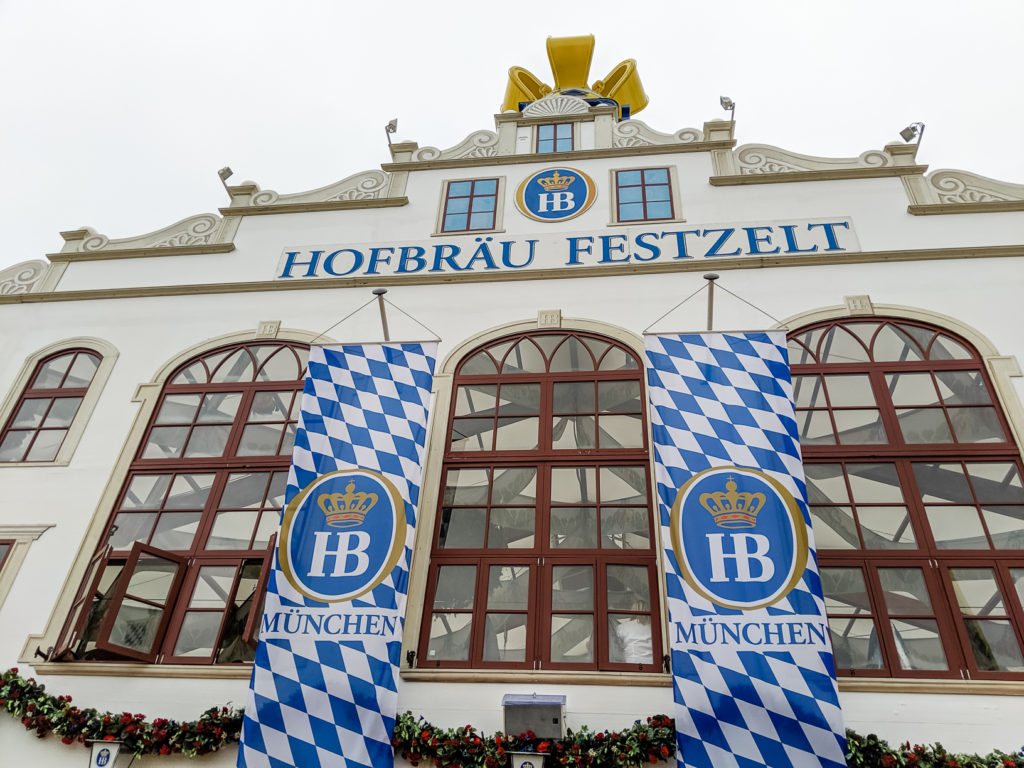
Oktoberfest Guide to the Tents
By far, the highlight of attending Oktoberfest is the tents. When I first got to the fest and I wandered around, I remember thinking, “There are not too many people here!” But when we entered the tents, I understood where everyone was 😀The tents will probably be where you spent a majority of your time at Oktoberfest.
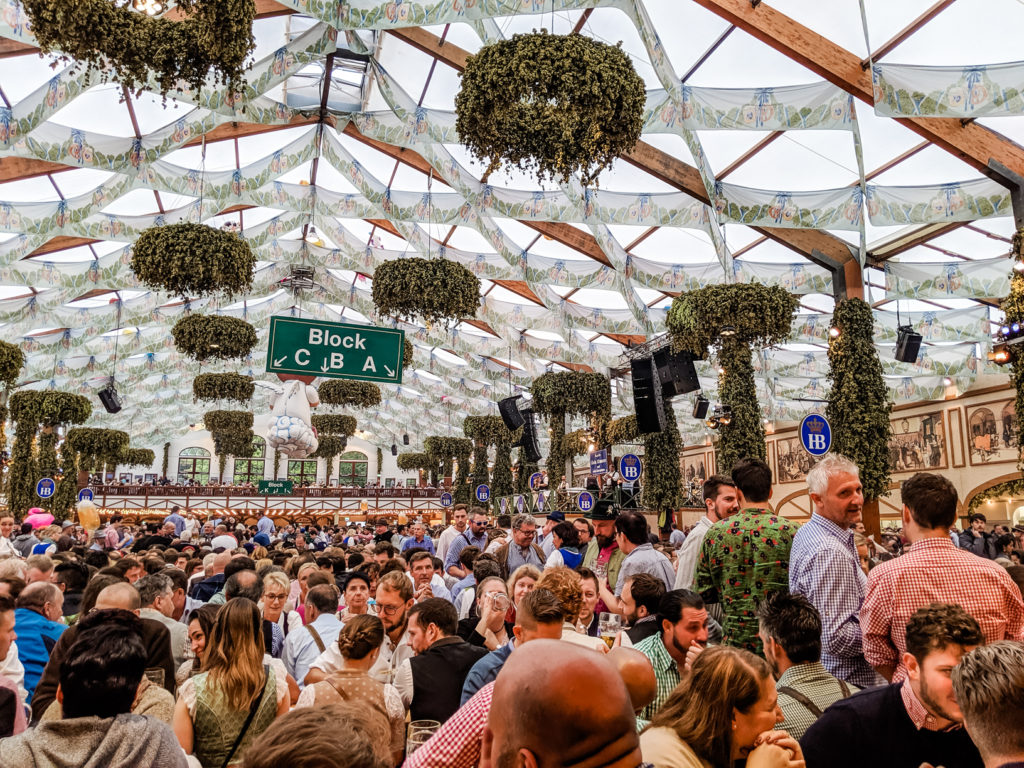
How to get a seat in a tent
Unless you get to the festival right when it opens, you’ll have to look for a seat in each of the tents. If you are looking for a seat during the day, but before the dinner reservations (which fill in around 5 p.m.), then you are going to have to search around the tents for a seat.
Once you’ve found a tent you want to find a seat in, wander around, and see if you can find an area that looks like it will fit your group (the fewer people you have with you, the better of a chance you will have to find a seat). If you see seating available, then hold up a number of fingers to the people around the spot. Even if they don’t speak English, they will let you know if the seat is available or not. You may have to do this a few times or check a few tents before you find a spot that isn’t otherwise occupied. Just keep moving, and don’t be nervous to hold up fingers whenever you think you’ve found a spot – people will very quickly let you know if or when a spot is open (or not)! This isn’t a time to be embarrassed, so don’t be afraid to ask!
Make sure you take a look at the end of the tables before you sit down. If the table will be cleared out for a dinner reservation, it will have a piece of paper on the end that will state the time that it has to be vacated.
PRO TIP: Get to Oktoberfest early to get a seat. Finding a seat without a reservation will be harder the later it is in the day. If you find a seat around dinnertime, stay there! You won’t be able to move, but you won’t want to – the party is at its best at night!
Even with big groups, we have been able to get seats without a problem. The only time we couldn’t find something is at 6 p.m. on a Sunday. Even if we were wandering around looking for a seat, a waitress would usually stop us if someone was getting ready to leave and we would wait for that seat to be vacated.
Most tents also have outdoor beer gardens where the exact same menus are sold. The only difference is you are outside, so you won’t get the same atmosphere as sitting inside. However, this is a great alternative if the tents are full up or if you have a big group. Be aware that Smoking is less of a taboo in Europe, and also not allowed in the tents, so a lot of people who sit outside are there to have a cigarette.
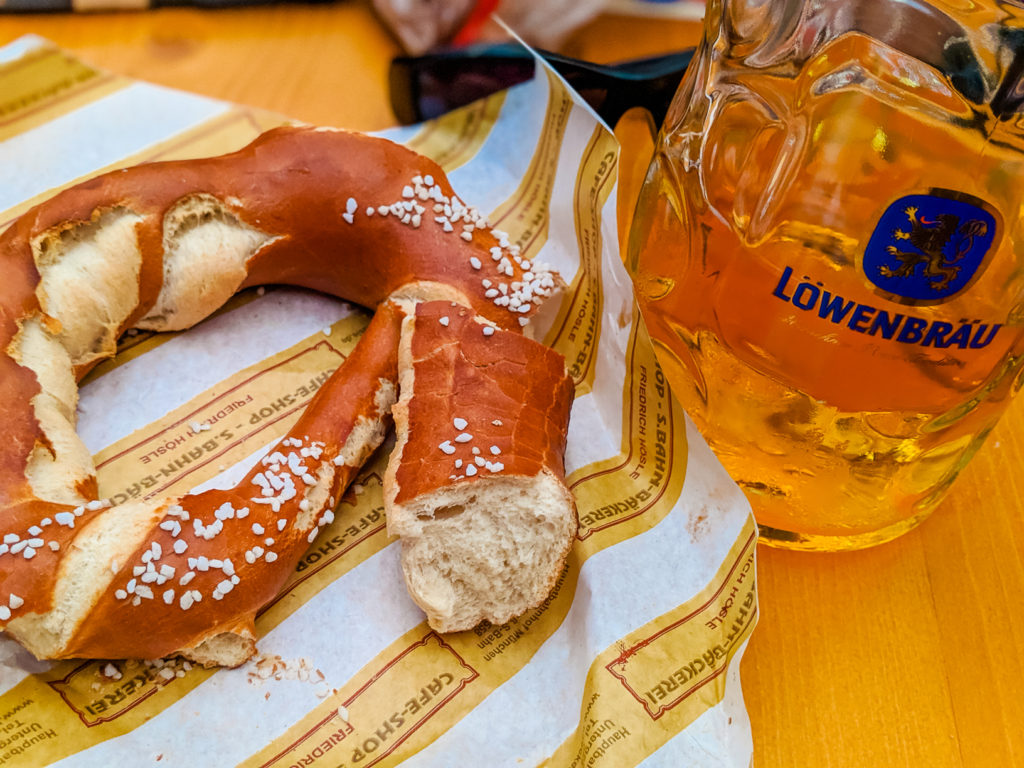
What do I drink?
All 14 Oktoberfest tents serve one of six different German beers: Paulaner, Spaten, Hacker-Pschoor, Augustiner, Hofbrau or Lowenbrau. Every tent will serve only one of these brands, and all will only serve Oktoberfest-style beers. Thanks to the German purity law, which says that beer brewed in Germany can only be made from hops, wheat, and water, German beer is some of the purest out there and has a different taste than most American beers.
When you order a beer in an Oktoberfest tent, you will be served the tent’s Oktoberfest-brand of beer. However, you can also order a non-alcoholic beer or a Radler. A Radler is a half-lemonade and half-beer combination. It’s particularly loved by Germans because it keeps you from getting too drunk, too fast. You can also order water, which will cost you a few Euros and also come in a stein. However, most Europeans drink sparkling water, so make sure to indicate if you want still water.
When you sit down and order, waitresses will automatically bring you a stein of beer. However, you can also order a half-stein of beer. This will cost you more in the end, so if you plan to drink a stein’s worth then order a full stein.
All beers will cost you around €12-13 including tip. Each tent has to serve beer for the same price range, and all prices have to be posted somewhere in the tent. Prices change year over year, so make sure to look up the prices on the Oktoberfest website so you can budget with cash before you arrive.
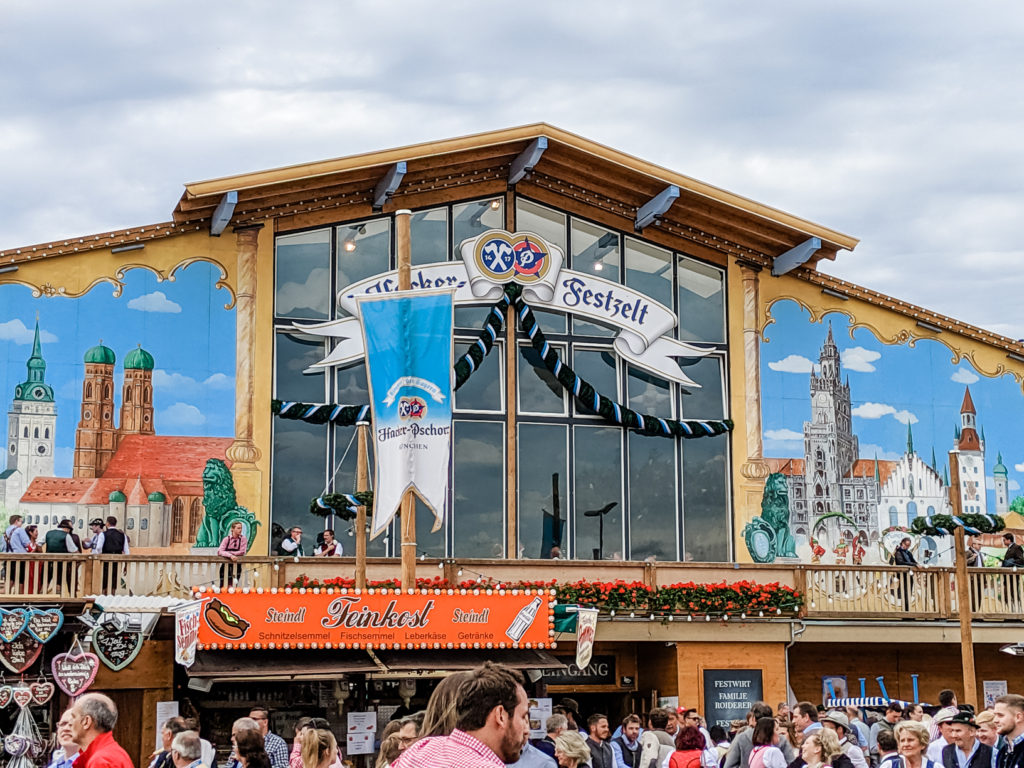
What to do in the Tents
Once you sit down, a waitress will come up to you and will ask what you want to drink. You MUST be drinking or eating if you are sitting, otherwise, they will ask you to leave. Even if you don’t want a drink, the tents serve non-alcoholic beer.
Once you’ve ordered, the waitress will bring back your beers and you will need to pay her in cash immediately. Don’t forget to tip! If you want something to eat, ask for an English menu or stop one of the bread ladies that are walking around (I highly recommend you have one of the big pretzels to soak up some beer).
Once you have a seat and a beer, then sit back and start enjoying it all! You’ve made it and you’re drinking in Oktoberfest! Listen to the band, sing a few rounds of “Ein Prosit” and take it all in. I also highly recommend trying to talk to the people around you. Germans love to talk about the Weisn to tourists and recommend other things to do while you are in Munich.
If you hear people cheering while you’re sitting in a tent, looking around. This is because someone is standing on a table and chugging a beer. Especially in the bigger tents, those who stand on tables have to do so before security comes to kick them out. So everyone will cheer them on as they chug their beer quickly!
If you are in a tent at nighttime, people will start standing on the tables and benches and dancing to the bands. Rather than traditional music, bands start playing Top 40’s-style music around dinnertime. Be careful – it’s very easy to fall off!
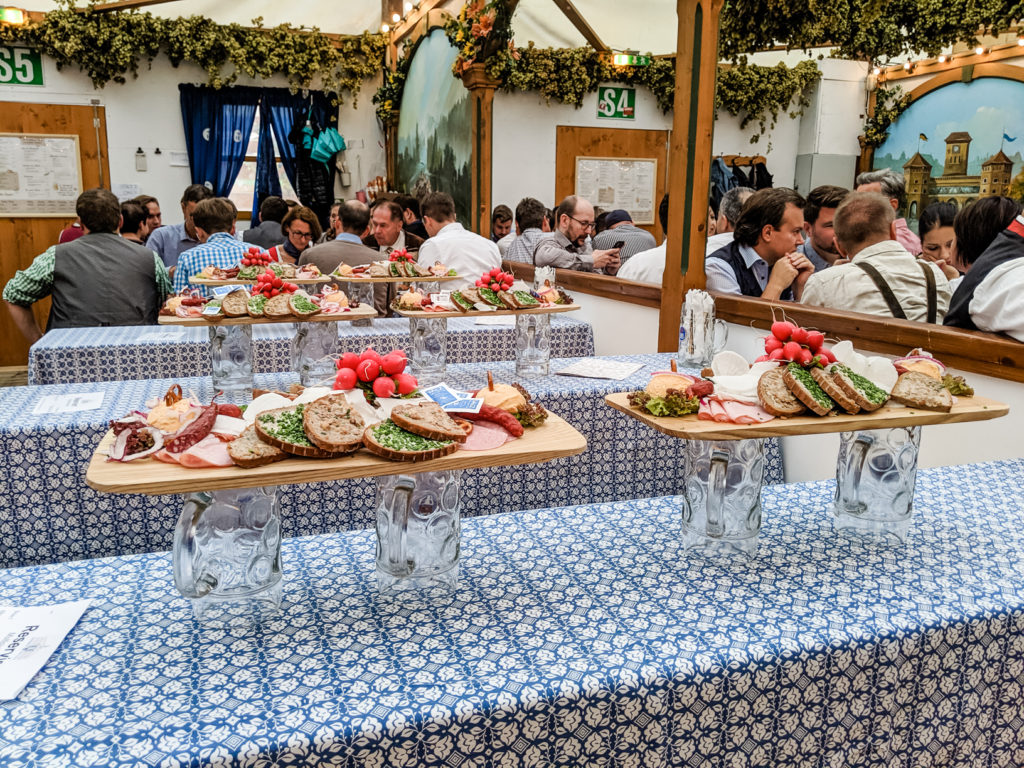
Should I get reservations?
Reservations will ensure that you have seats, especially around dinnertime. However, they must be made in advance – usually months and months in advance. You can try to make them a few weeks beforehand, but most of the “popular” tents will be reserved very quickly. Those who made a reservation get the first opportunity to reserve, followed by the rest of the general public.
Reservations can be made online via each tent’s website (use a browser plug-in to translate the German websites). They are typically made for 10 people, and the price includes food (usually a plate of snacks or a half a chicken) and a beer or two. You don’t have to have ten people at the table, but the price will reflect that amount. You can prepay for your reservation online, and then you pick up your tickets inside the tent beforehand.
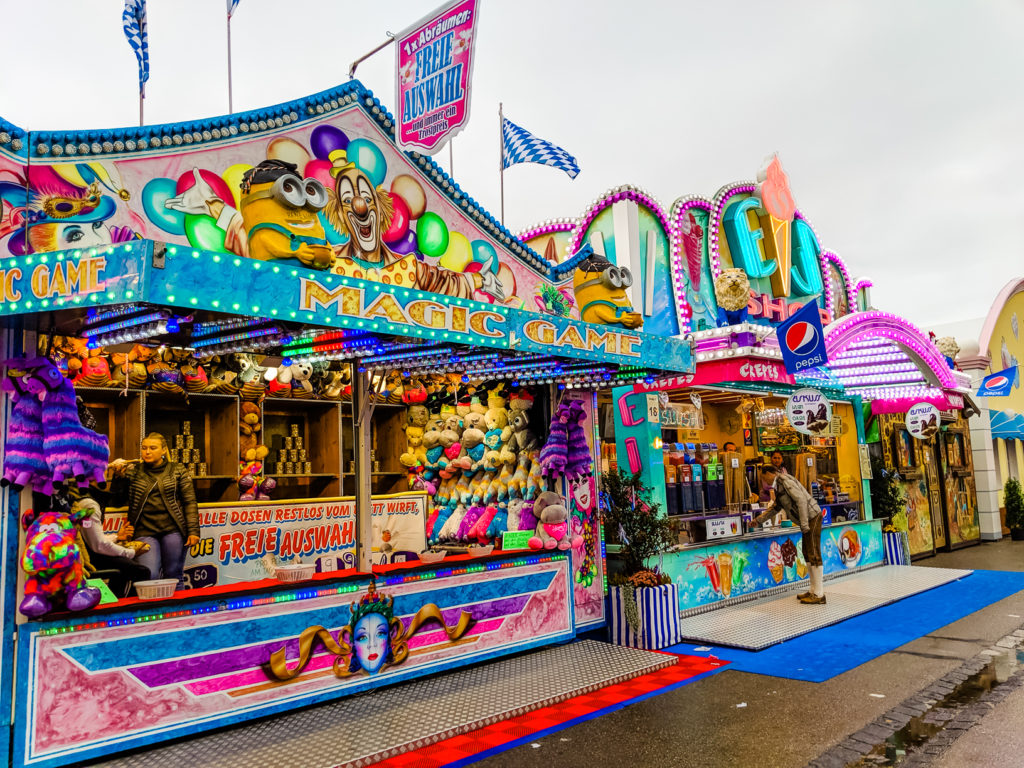
Oktoberfest Guide to Activities
There is more to Oktoberfest than the beer! I highly recommend spending some time outside of the tents and taking in the festival as a whole.
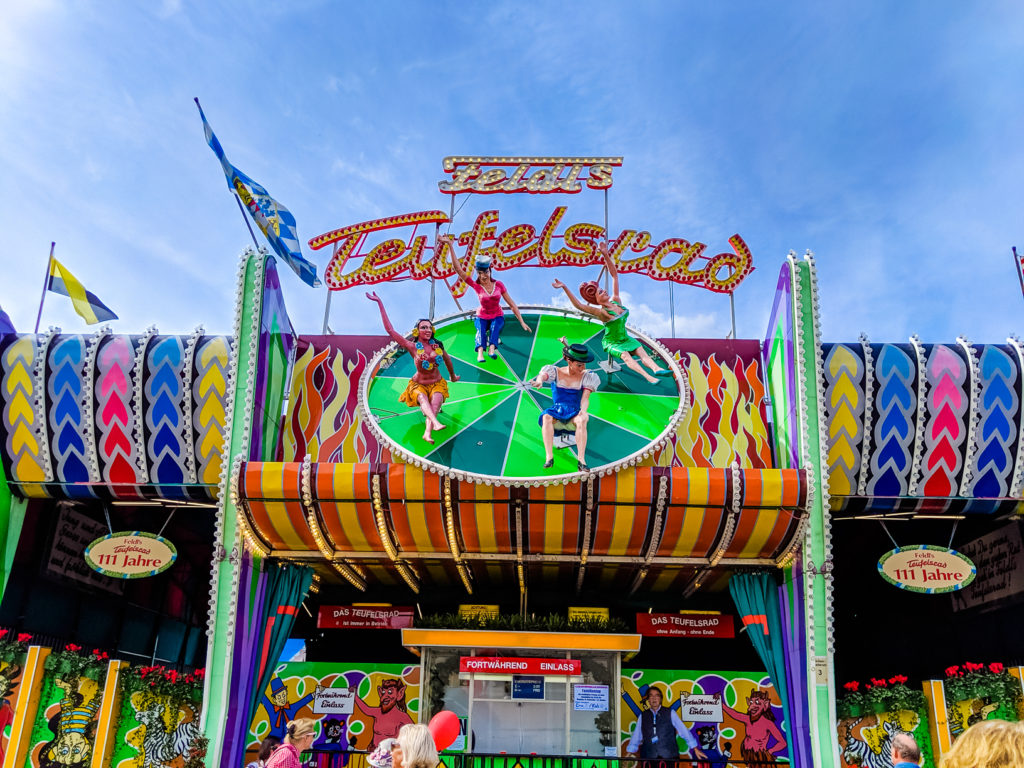
The Festival
Oktoberfest is part of a large fun festival, complete with rides, food and other activities. The festival includes a full roller coaster, a drop tower, and other fun rides. Take some time to walk around and take it all in. Don’t forget to try some German festival food!
My favorite part of the festival is the Devil’s Wheel. At this show, an announcer calls out different demographics (such as “all women in dirndls!” or “all men under 50!”) and they all rush to sit on a wheel in the middle of the room. The wheel then spins around, trying to knock the contestants off. Ropes and beach balls are thrown in when contestants stay on too long, making the show even funnier. I highly recommend spending the €5 entrance fee to watch this – just remember that the whole thing is in German, so don’t hop in unless you’re sure you fit in with the demographic that was called!
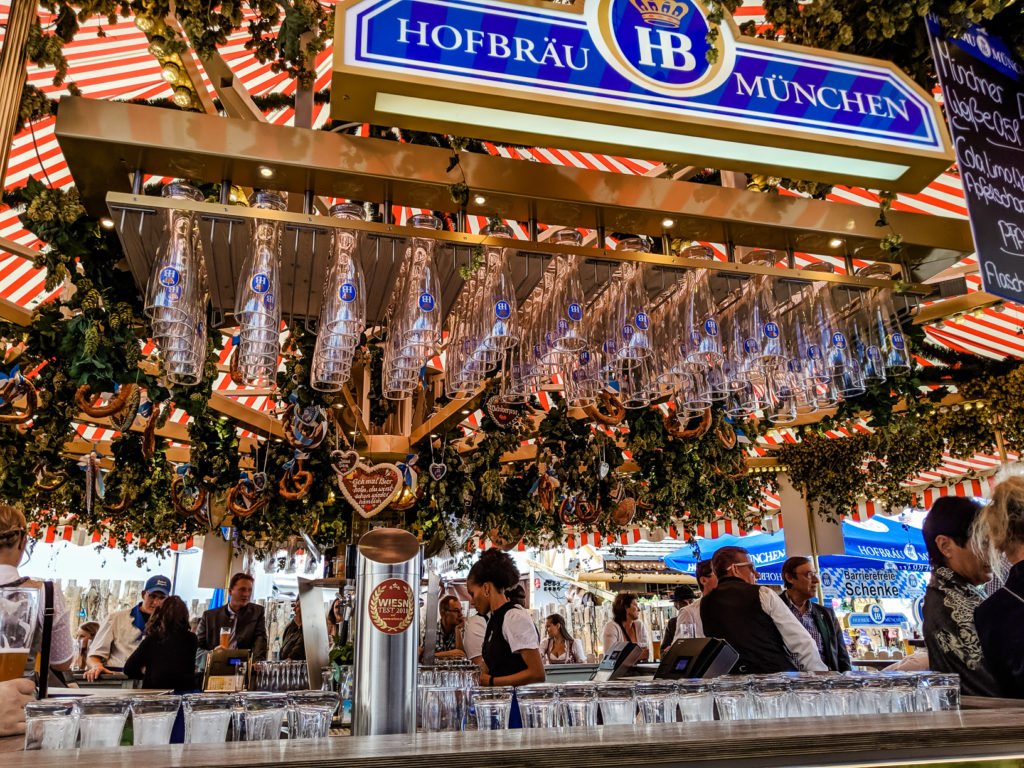
Small Tents
In addition to the 14 large tents, there are 21 smaller tents throughout Oktoberfest. They have significantly less capacity than the large tents, but they are much less crowded. These tents also serve different types of beer than Oktoberfest, including lagers and wheat beers. These are a great place to go when you’re sick of Oktoberfest beer, or if you want to try something different. They’re also fun to stop in as you walk around and take in the festival. One of the small tents we found was a spinning carousel – complete with a tent dog that barked at you when you sat down! J
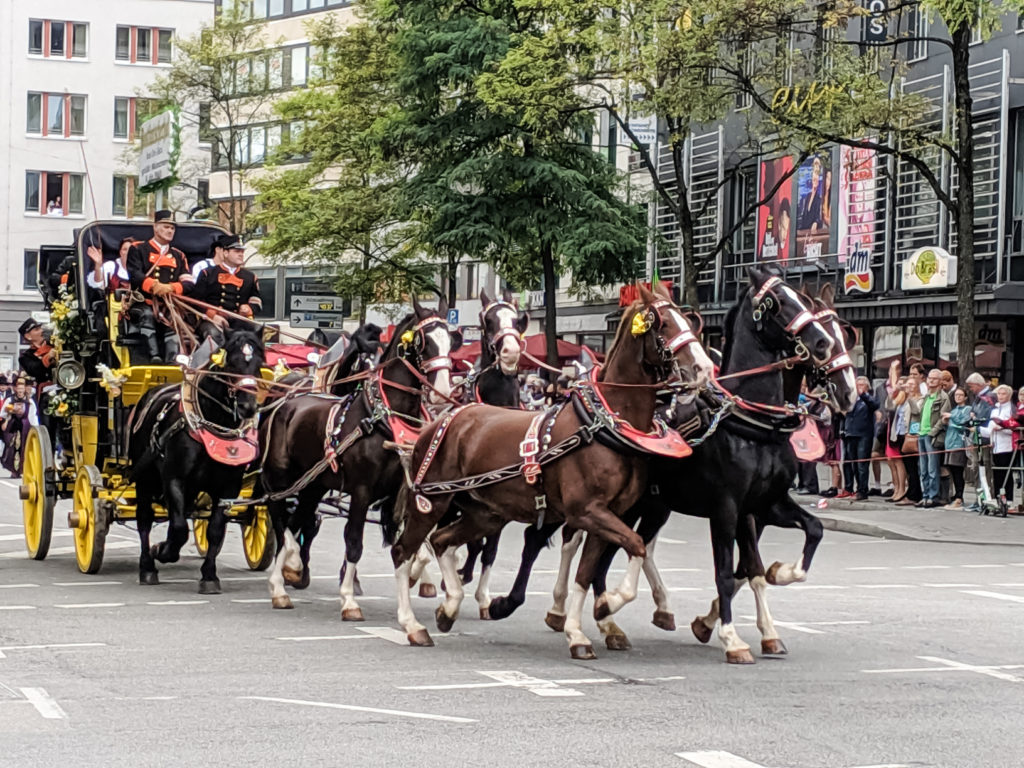
Keg Tapping & The Parades
Throughout Oktoberfest, the festival will hold different events, including the tapping of the keg, parades and even a church service! While not a requirement for attendees, these are a great way to understand the spirit of the festival. Take a look at the Oktoberfest website to see when each of these events is happening – some, like the keg tapping, may affect when the festival starts for the day, so be aware of these events, especially on weekends! We were able to catch the costume parade outside of our hotel the day we arrived, which was a great way to start off our week at the fest.
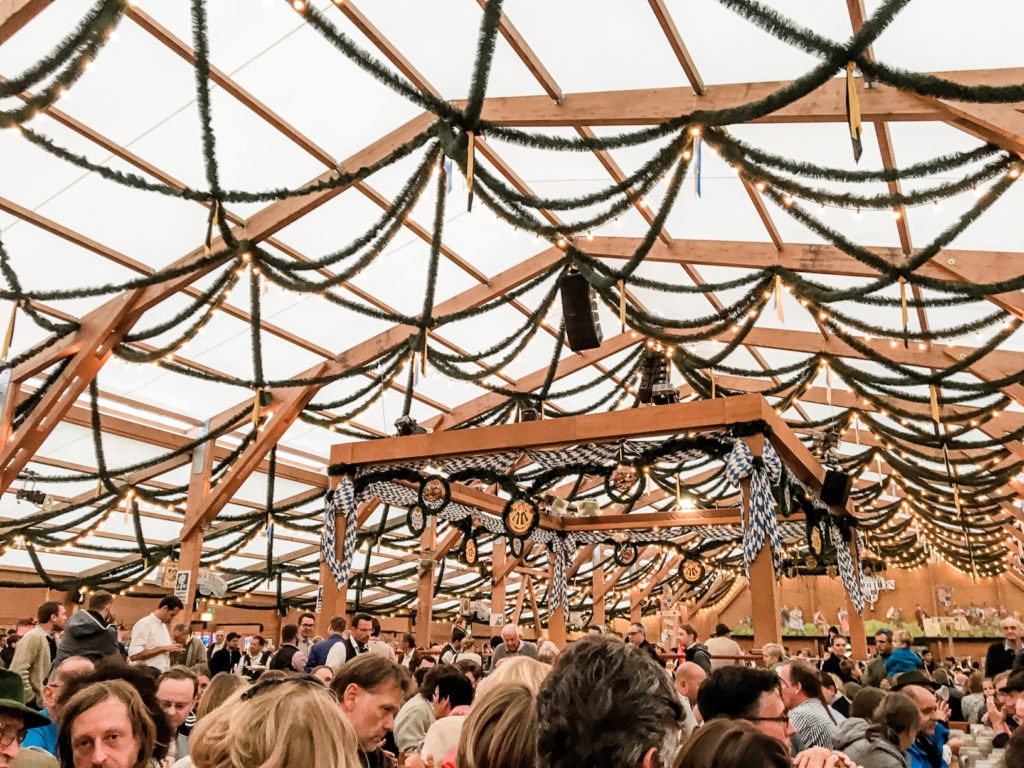
The Olde Weisn
In 2010, Oktoberfest made a one-off event to celebrate the beginnings of the festival, complete with old-style rides and displays. The residents of Munich love it so much that it became a regular part of Oktoberfest – and the Olde Weisn was born! Located in the back of Theresienwiese, it costs €1 to get into this area of Oktoberfest – and because of it, many tourists will never come back here. This area is much less crowded and if you’re struggling to find a seat then we highly recommend heading back here. The tents are much more “authentic” with classical music and dancing, authentic food, old-fashioned decorations, – even the steins back here are styled like old-time mugs! It’s also worth it to spend time back here as the games, rides, and food are similarly discounted.
The Olde Weisn Oktoberfest only happens for three years, takes one year off for the agricultural festival, and then starts again. It was scheduled to be off for 2020, which is good news for those who want to visit in 2021! I highly, highly recommend checking this place out, even if it’s for your first beer of the day. It’s a true and authentic experience, and even if you don’t stay long, you’ll really get the Oktoberfest “feel” when you visit.
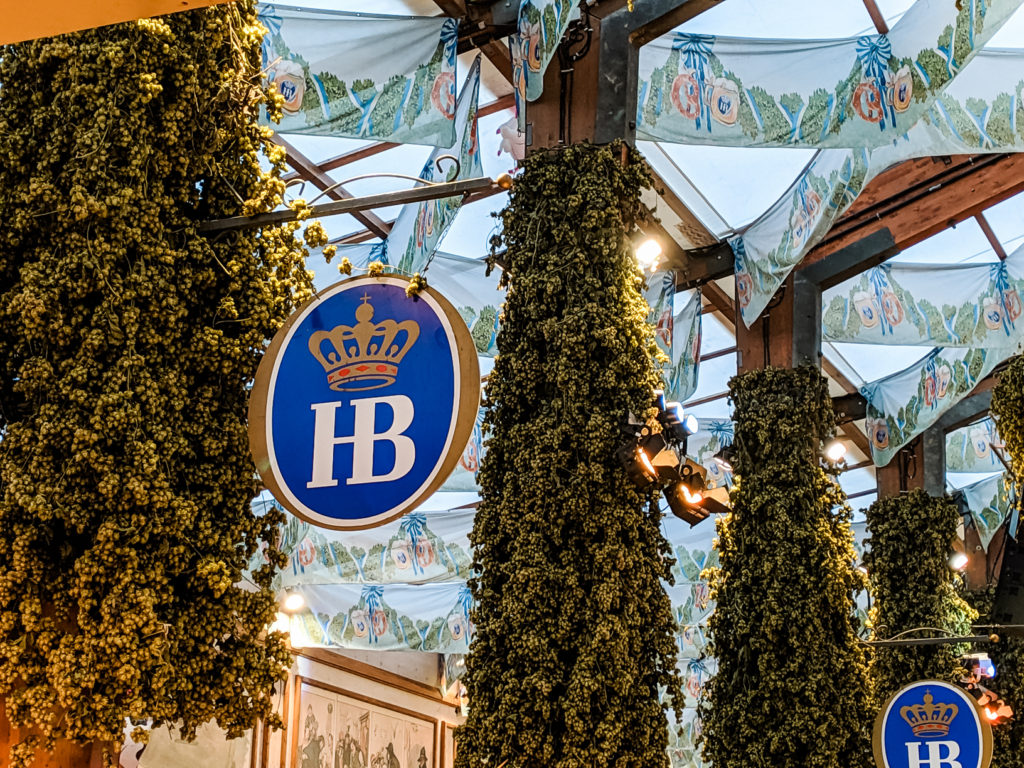
Oktoberfest Guide & Tips
While this Oktoberfest guide is extensive, it doesn’t cover everything. Here are a few additional tips to know before your time at the Weisn:
- You don’t need tickets – A lot of people are under the mistaken idea that Oktoberfest is like a “normal” beer festival and you need tickets to enter. Not true! Anyone can walk off the street and right into Oktoberfest.
- Download the app – There’s an app for that! The festival has an app that has an interactive map that allows you to click on each tent and see its capacity. This is a great way to figure out which tent you’ll be likely to get a seat in. The app also includes all of the information you’ll need to know when at the fest, including hours, any events happening that day and relevant push notifications.
- Drink water – No, but really. Even though it costs money to get a glass of water, it should be one of the top things on your list! Otherwise, your time at the festival could be cut short – if you get sick while sitting at an Oktoberfest table, you will find yourself being escorted out. So, hydrate!
- Watch the live cameras – The Oktoberfest website has a variety of webcams throughout the festival. This is a great way to see where the festival is in terms of capacity and also get a feel of where you want to head when you go to the festival for the first time.
- Put extra cash somewhere secret – Hide some cash somewhere on your person so you always have some money on you in case of emergency. I always tuck a €20 into my bra so that way if I am separated from my husband (who keeps all of our cash safely buttoned away in his trachten), I am still able to get home without a problem.
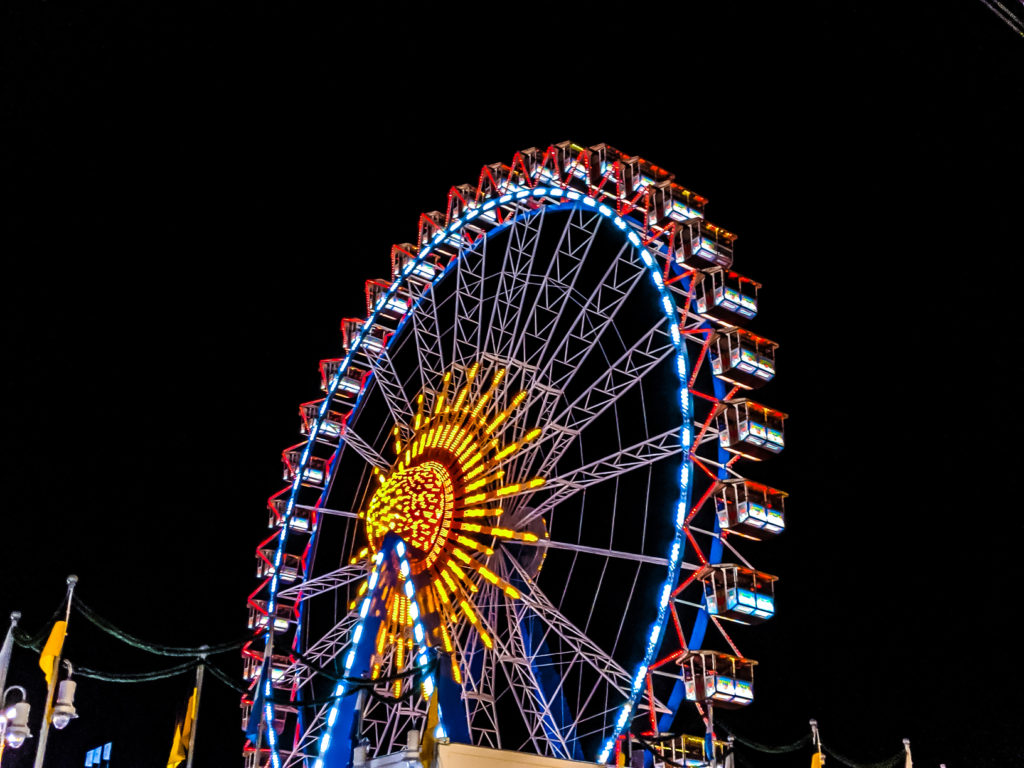
German Phrases to Know
No Oktoberfest guide would be complete without some German phrases! Outside of the waitresses, almost everyone will speak German – so make sure to have these in your back pocket so you can communicate the basics with everyone.
- Prost! = Cheers!
- Guten tag = Good day (This can be used as “hello”)
- Danke = Thank you
- Entschuldigen = Excuse me
- Sorry = Sorry
- Ein Bier Bitte = One beer, please
- And don’t forget to learn all of the words to Ein Prosit! You will be singing it a lot while sitting in the tents.
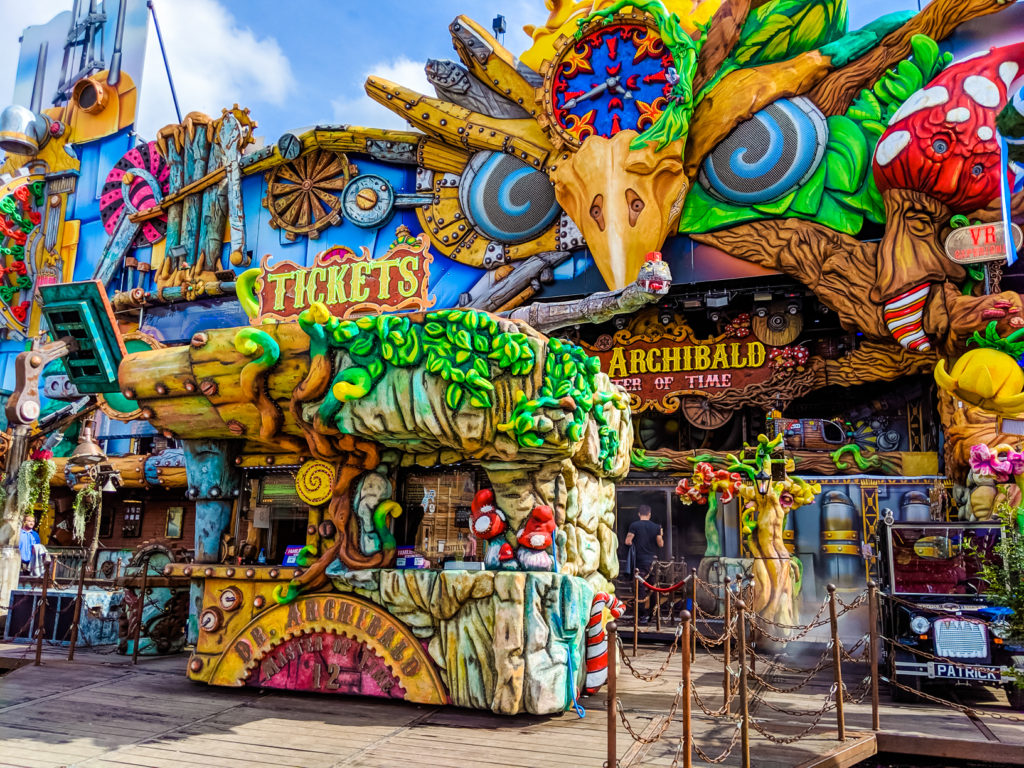
Looking for other ideas of what to do while in Europe? The second time we headed to Oktoberfest, we split the week we spent in Europe with a few days in Ireland. In addition to this Oktoberfest guide, here are some tips we found while in Ireland:
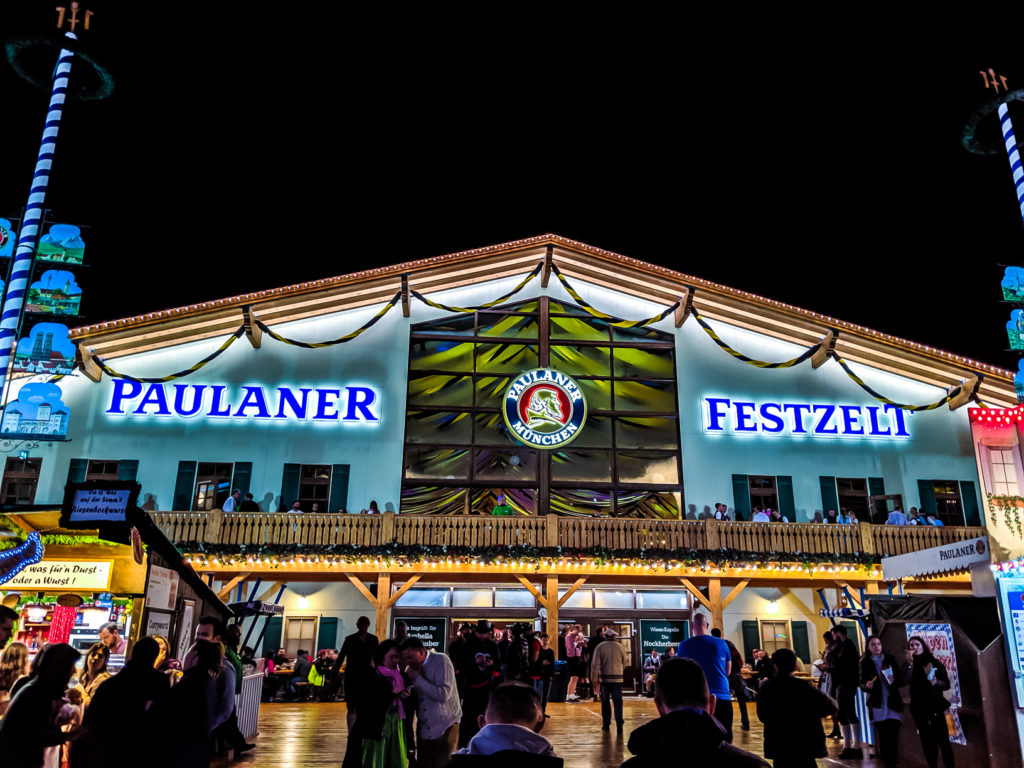
Any Questions?
Hopefully, this extensive Oktoberfest guide helped you understand everything you need to know about the fest. But if you still have questions, feel free to ask away in the comments and I will get back to you ASAP!
Want to see more of our time at Oktoberfest? Take a look at my Instagram stories (under the Oktoberfest highlight). Have you been to Oktoberfest? What did you enjoy? Do you want to go? What are you looking forward to the most? Have you used this Oktoberfest guide? What did you enjoy about this Oktoberfest guide? Make sure to comment below.
And don’t forget to save this Oktoberfest guide for later via the images below.
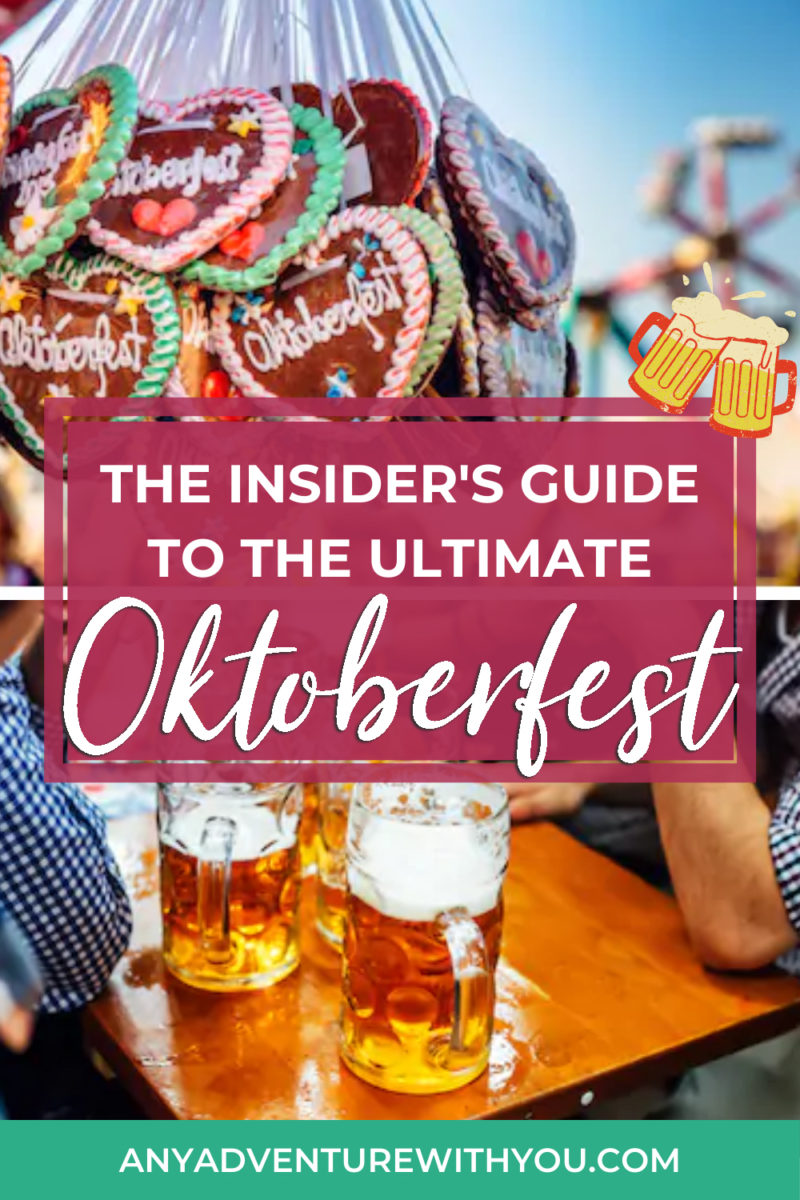
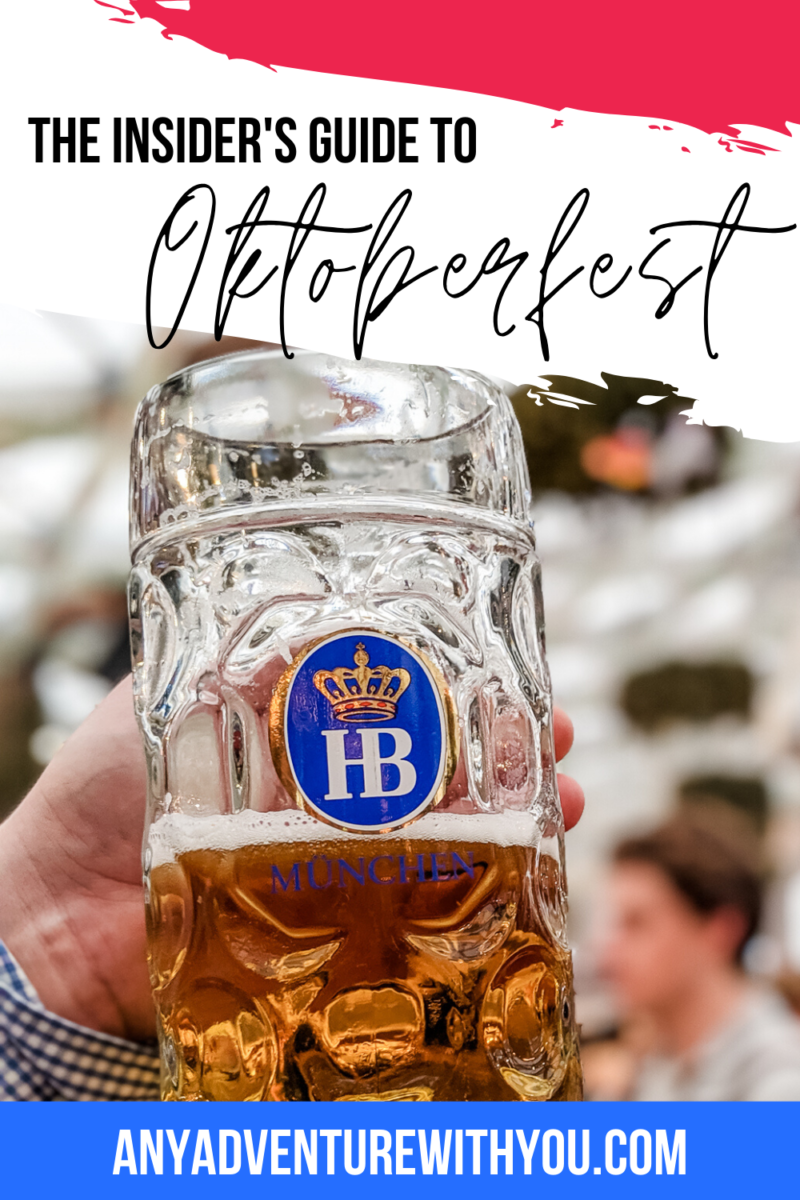
This was such an informative blog! I loved Germany and want to go back during Octoberfest!
I loved your post! Thank you for all the detailed info. Can’t wait to get to there.
This is a great guide for Octoberfest. I’d really love to go.
Oktoberfest is on my bucket list! I’ve been to Munich before, and can only imagine the buzz there must be at that time of year. Fab post, so informative!
These are great tips for Oktoberfest. We always have a blast when we attend and can’t wait till we make it back again in a couple of years. Hopefully I will be able to keep a lot of your tips in mind so that our fun is even better.
What an amazing and thorough guide!! One I will definitely be saving for future use, as Oktoberfest in Germany is on my bucket list. My husband went years ago, loved it and I’m sure he wouldn’t mind returning.
I have been to Germany, but never got to the Octoberfest. I hope to implement this idea this year! Thanks for the guide!